March 22nd, 2018 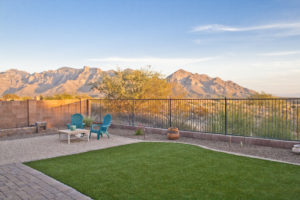 Once upon a time, we had lush, green, soft natural grass in our backyard. Sometimes. However, in the winter if we didn’t overseed the grass and it went dormant it became brown, crispy, and ugly. Maintaining the grass to keep it looking beautiful involved reluctant mowing, the occasional edging, lawnmower maintenance, yearly overseeding, and a whole lot of water. Eventually we got tired of wasting water & taking care of the grass, and we simply shut off the water to it. Talk about brown, crispy, and ugly! Winter rolled around and the grass went dormant, then gradually deteriorated further, finally leaving our backyard in shambles. However, there was suddenly a clear difference in our water bill when we shut off the water. While reducing our bills was a welcome byproduct, the primary reason for shutting off our water was simple water conservation. Once upon a time, we had lush, green, soft natural grass in our backyard. Sometimes. However, in the winter if we didn’t overseed the grass and it went dormant it became brown, crispy, and ugly. Maintaining the grass to keep it looking beautiful involved reluctant mowing, the occasional edging, lawnmower maintenance, yearly overseeding, and a whole lot of water. Eventually we got tired of wasting water & taking care of the grass, and we simply shut off the water to it. Talk about brown, crispy, and ugly! Winter rolled around and the grass went dormant, then gradually deteriorated further, finally leaving our backyard in shambles. However, there was suddenly a clear difference in our water bill when we shut off the water. While reducing our bills was a welcome byproduct, the primary reason for shutting off our water was simple water conservation.
In Tucson, about 40% of the potable water is used on landscapes (Tucson Country Club Estates is the largest water user in the area according to data from Tucson Water). There are many ways to avoid this, including by using only native plants and harvesting rainwater. Rainwater harvesting can be accomplished in multiple ways, like passively via berms & swales and actively via gutters & cisterns. You might be surprised to learn that enough water falls from the sky every year to cover our entire water needs in Tucson IF those needs don’t include things like grass.
Through education, a reduction in landscape watering, and other proactive means the water usage in Tucson has shrunk from an average gallons per capita per day of 121 GPCD in 1996 down to 94 GPCD in 2010. This is slightly above the US average in 2010 of 88 GPCD, but well below Arizona’s hefty 147 GPCD. This enormous Arizona figure is largely thanks to all of those lawns in the Phoenix area. By 2015, Tucson had further reduced its GPCD down to 80 GPCD! Through our own reduction in watering natural grass and other lifestyle changes, we’re averaging around 40 GPCD for our household!
https://mapazdashboard.arizona.edu/infrastructure/residential-water-use:

So though we had decided to stop fighting the uphill battle that was our lawn, we still wanted to brighten up our backyard last summer and make it an inviting place to spend time. Ultimately we decided to replace part of our lawn area with artificial grass. We would have replaced the entire thing, but yes, artificial turf IS fairly expensive. Therefore, we replaced half of the old grass area with artificial grass and laid decorative rock in place of the other half.
Artificial grass was first used in the Houston Astrodome in 1966, and boy has it come a long way! You can find all kinds of varieties of grass, each mimicking a different type of real grass. In fact, there are so many options out there, that it made choosing very difficult. Home Depot only had four different varieties that we could touch for ourselves, and the other suppliers were located so far away, that it was going to be a hassle to visit them all. It would have been nice to have one large showroom with all of the different types available to do a side-by-side comparison, but alas, each company only carries particular varieties, so you’re probably better off choosing your installation company first and then comparing their selections.
We chose to work with Arizona Turf Masters and called up their estimator, Jeri Estrella. Jeri was very responsive and came out to our house to see the backyard and take measurements of the area we wanted replaced. She was knowledgeable, friendly, and not a pushy salesperson at all. Arizona Turf Masters is one arm of the company that does the installations, but for those DIY’ers you can purchase the turf through their affiliated company, The Synthetic Grass Store. We did hem and haw about doing this project on our own for the experience and to save some money but ultimately decided to let the professionals handle the install. That proved to be a wise decision as the professionals were in and out in just a single day with a very neatly done job.
So whether your motives are a long term financial savings on water bills or just to ease the burden of maintenance, switching to artificial grass could be the answer if you’re a natural grass owner. Even those with xeriscaped backyards may want to consider a little artificial grass to brighten up their yards too!
Below are some before & after photos of our backyard:
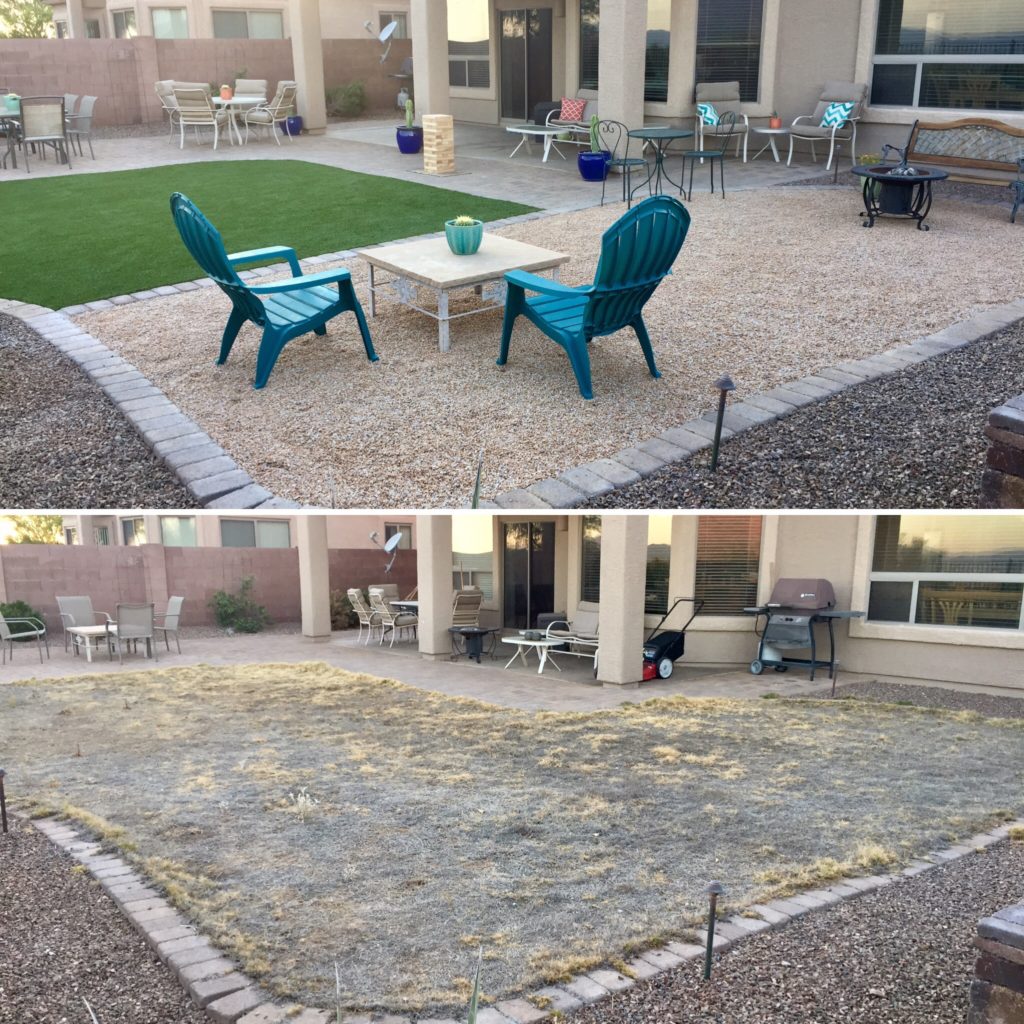 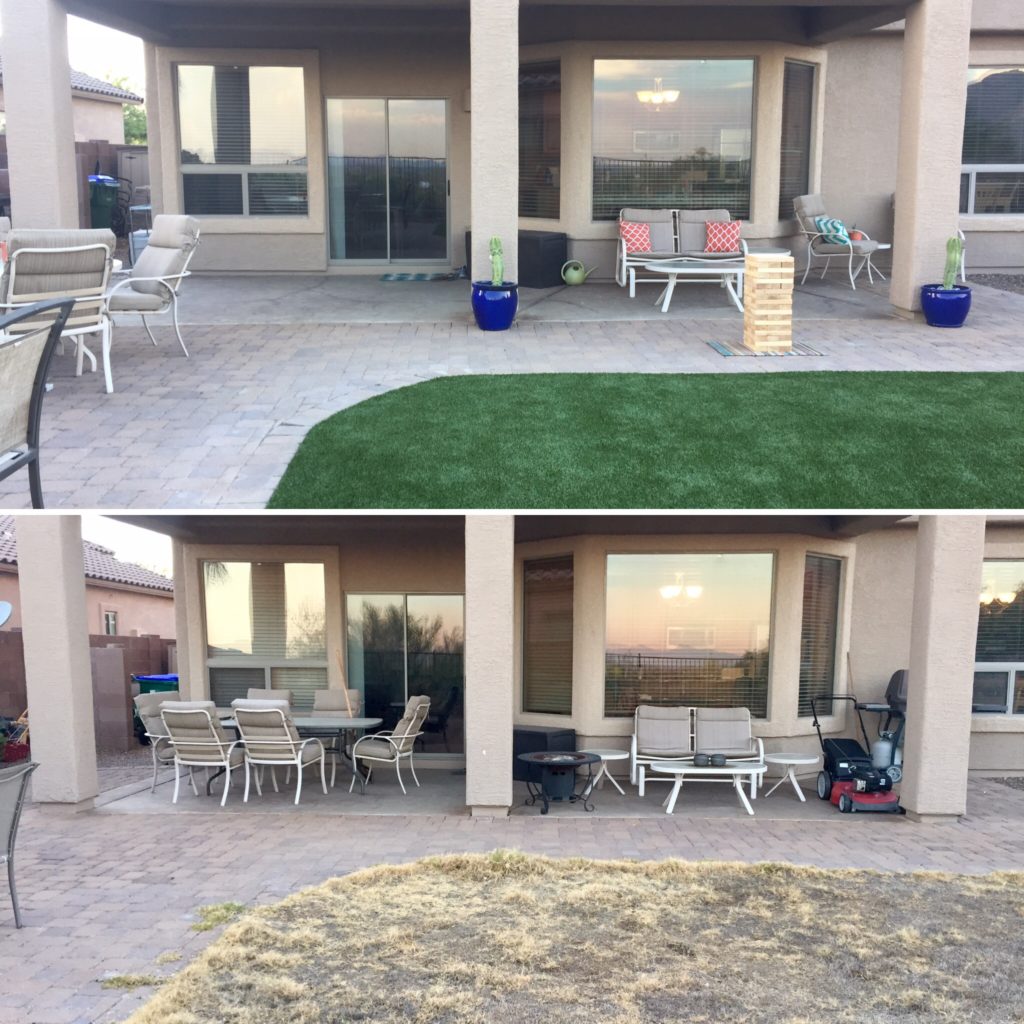 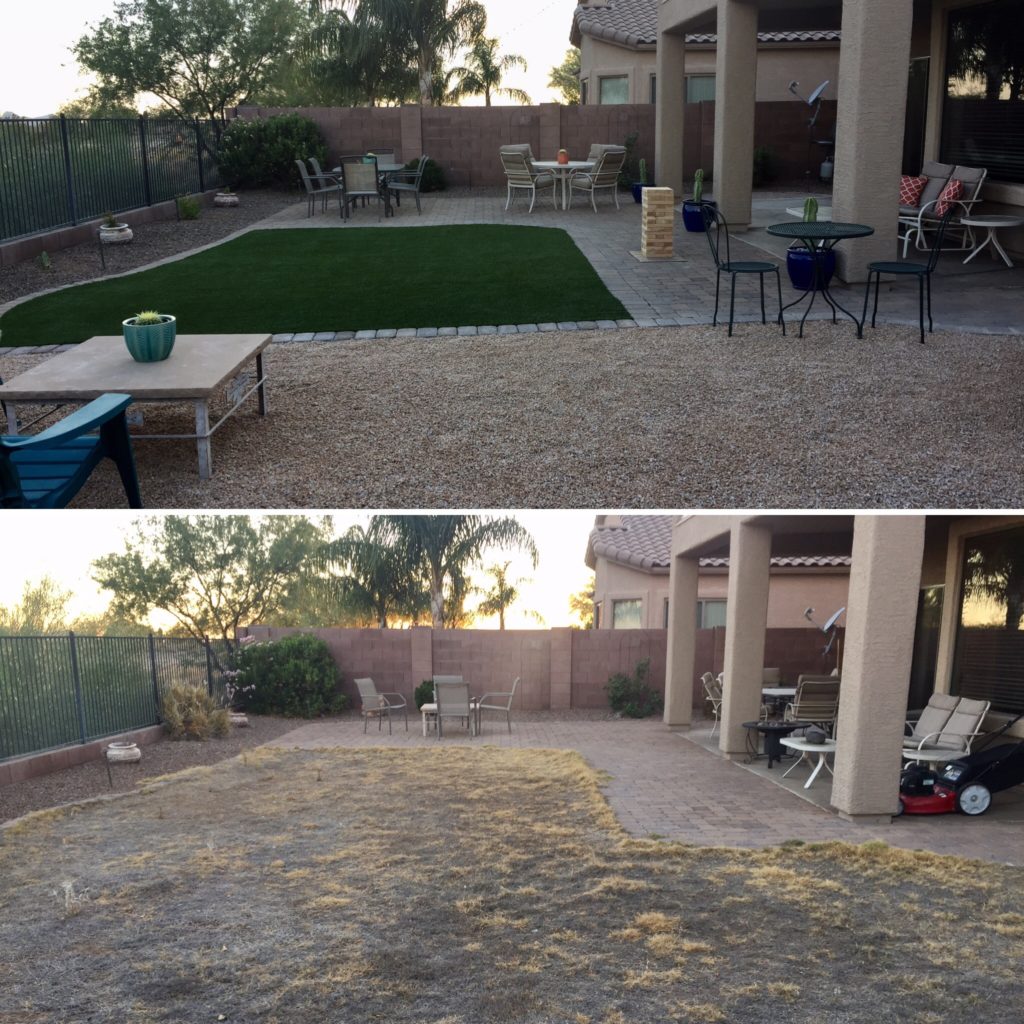  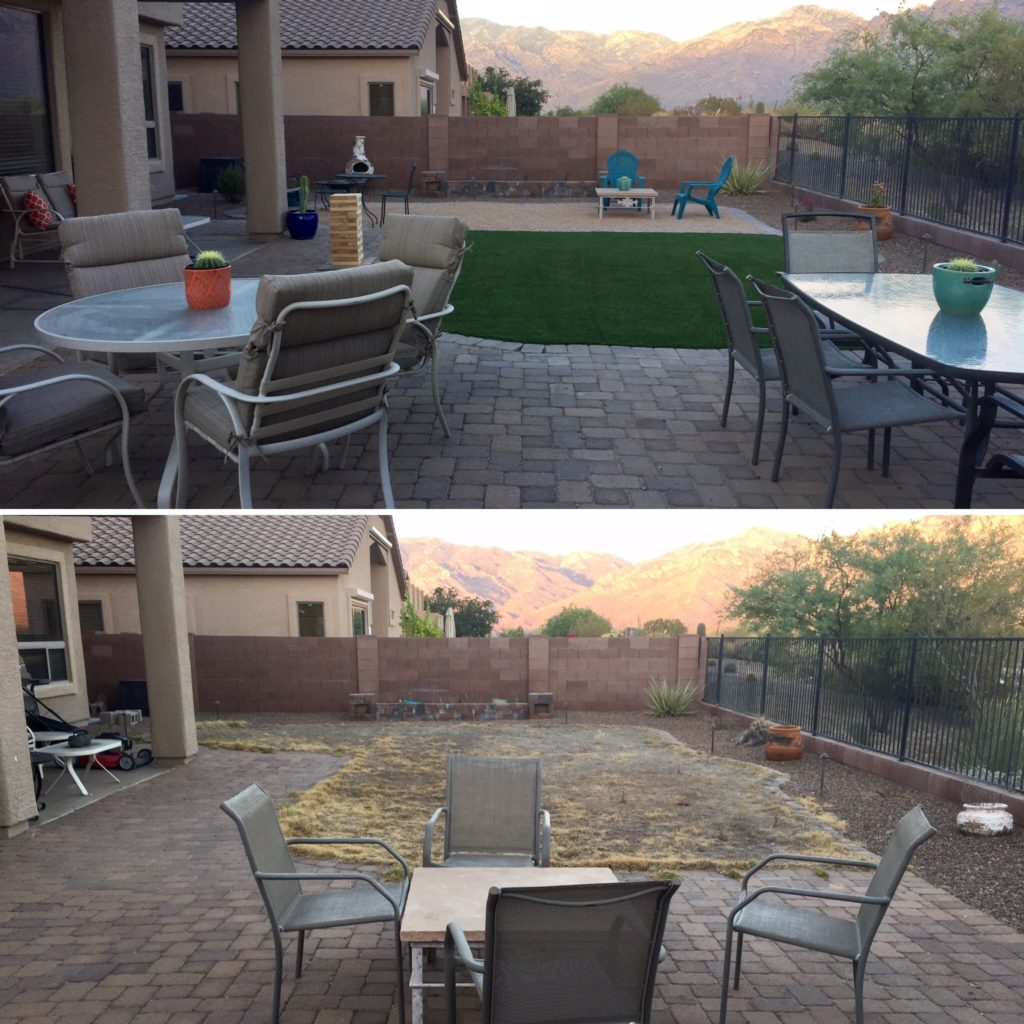 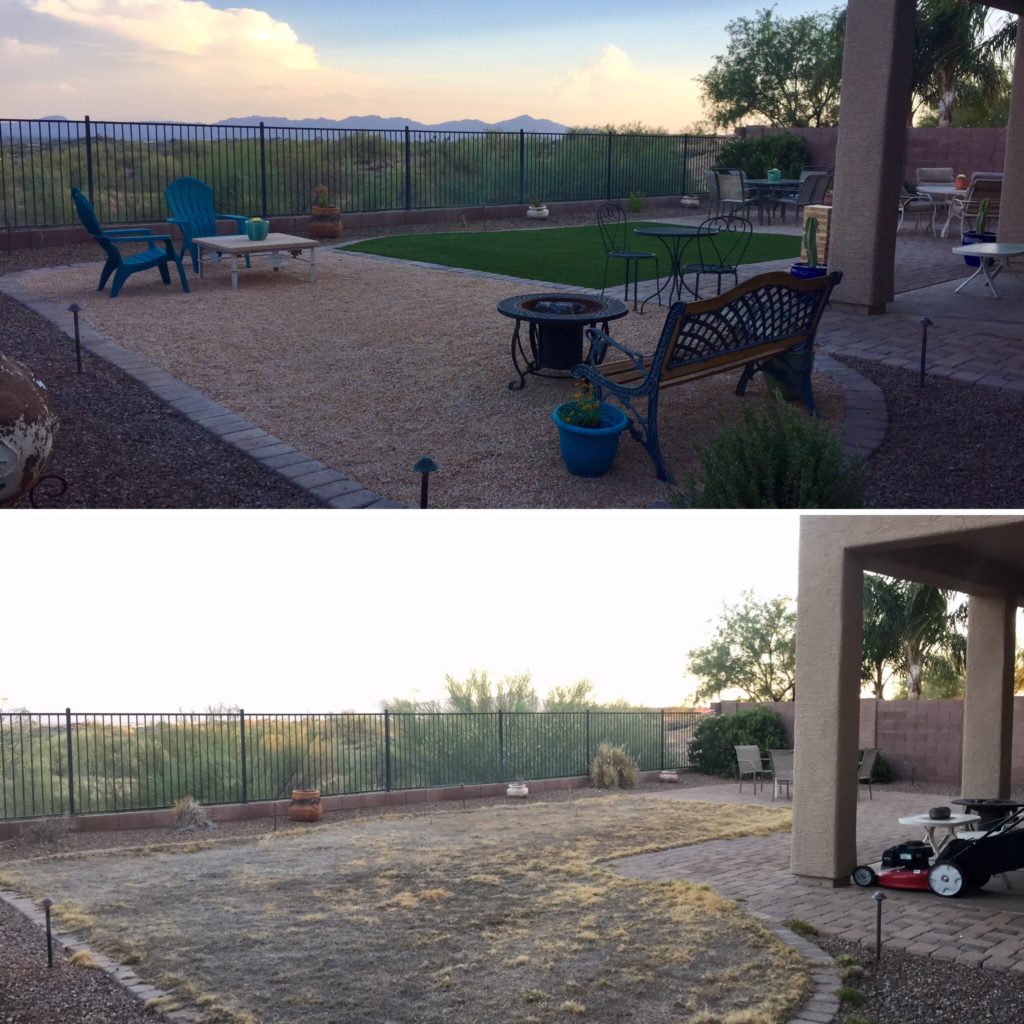
February 20th, 2018 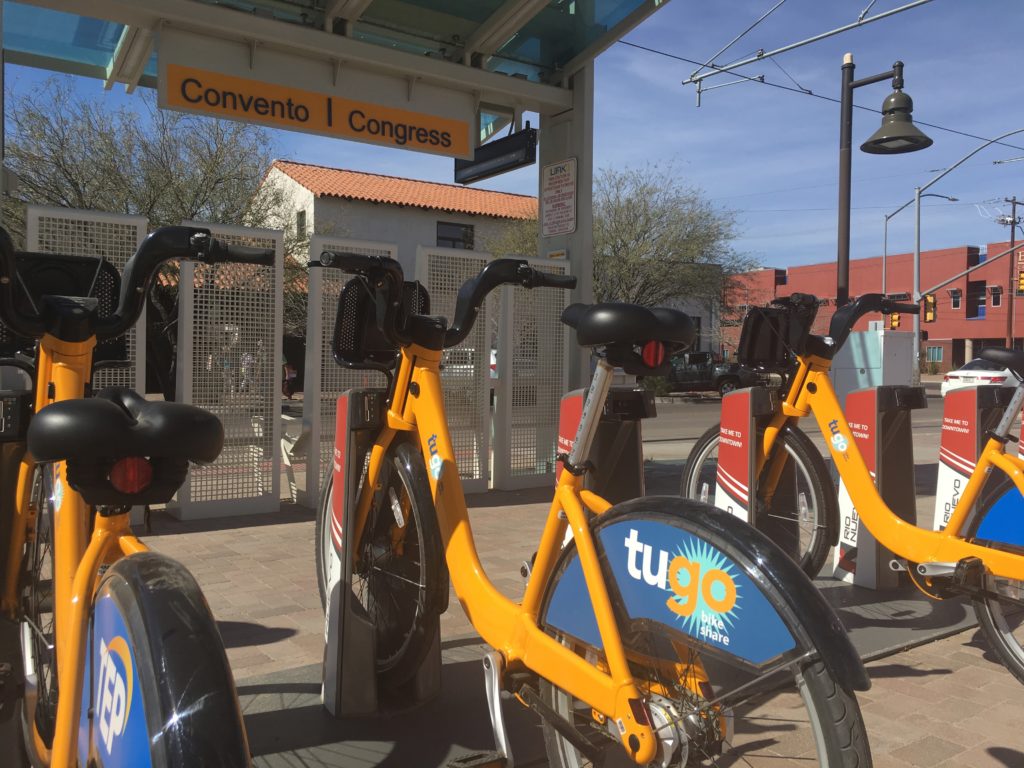 Bike sharing is popular around the world, but the United States has been a little late to the game. You may picture China as a smoggy, polluting place, but the vast majority of public bikes are found there, so you have to give them a little credit. Tucson was one of the first U.S. cities to attempt a bike share system, but before the advent of information technology that allowed for locking, unlocking, and charging for use, all of the bikes got stolen within the first few weeks of the program back in the mid-90’s. Now that sophisticated docking systems can be found in cities such as Boston, New York City, and San Francisco, it’s not surprising that Tucson, designated as a Gold Level Bicycle Friendly Community by the League of American Bicyclists, has jumped back on the bandwagon with a new and improved bike share system. Bike sharing is popular around the world, but the United States has been a little late to the game. You may picture China as a smoggy, polluting place, but the vast majority of public bikes are found there, so you have to give them a little credit. Tucson was one of the first U.S. cities to attempt a bike share system, but before the advent of information technology that allowed for locking, unlocking, and charging for use, all of the bikes got stolen within the first few weeks of the program back in the mid-90’s. Now that sophisticated docking systems can be found in cities such as Boston, New York City, and San Francisco, it’s not surprising that Tucson, designated as a Gold Level Bicycle Friendly Community by the League of American Bicyclists, has jumped back on the bandwagon with a new and improved bike share system.
The City of Tucson launched its TUGO Bike Share program in November 2017, and it currently has 330 bikes at 36 stations mostly around downtown Tucson. We decided to spend a day riding around on these bikes with stops at vacant homes on the market, Mercado San Agustin, Bisonwitches, the U of A, two of our favorite breweries – Borderlands and Tap & Bottle, the Originate Natural Building Materials showroom, and Tumamoc Hill. A day pass for a TUGO bike costs $8, but it’s $18 for a month, $80 for a year, or $5 for qualified individuals.
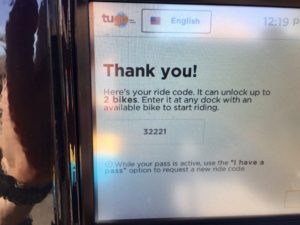 We purchased our day passes at the Tumamoc Hill station using a credit card and unlocked our first set of bikes…after struggling to figure out where to enter the 5-digit code to release the bike from the dock. Searching for a typical keypad, we eventually realized the 1-2-3 on the dock WAS the keypad as all codes are combinations of only those three numbers. Once on the bikes, the first thing we noticed was that TUGO bikes are heavy, and they only have three gears, none of which are high enough to get you going very fast, BUT if Krista Hansen of the city transportation department’s bike and pedestrian program can ride the entire 106-mile El Tour De Tucson on a TUGO bike, we could put up with it for 30 minute increments. We purchased our day passes at the Tumamoc Hill station using a credit card and unlocked our first set of bikes…after struggling to figure out where to enter the 5-digit code to release the bike from the dock. Searching for a typical keypad, we eventually realized the 1-2-3 on the dock WAS the keypad as all codes are combinations of only those three numbers. Once on the bikes, the first thing we noticed was that TUGO bikes are heavy, and they only have three gears, none of which are high enough to get you going very fast, BUT if Krista Hansen of the city transportation department’s bike and pedestrian program can ride the entire 106-mile El Tour De Tucson on a TUGO bike, we could put up with it for 30 minute increments.
TUGO bikes are not meant to be cruised on all day long. They are intended purely as commuter bikes. You only have 30 minutes to ride and return your bike to a station or you are charged $4 for additional 30-minute periods. If you arrive at a station and all of the docks are full, there is an option to extend your time for free so you can return it to a different station. Since the day passes provide you with unlimited rides for a 24 hour period, just check out a new (or the same) bike when you’re ready to move on. There were a few times when we docked our bikes to stop the 30 minute clock and then immediately unlocked them to start a new 30 minute timer.
Beware: Unlocking a bike requires that the station have a kiosk to read your credit card and dispense a new unlock code (codes are only valid for 5 minutes, so really just at that station), and for whatever reason, not all docking stations have kiosks. This means you can lock your bike up, but you can’t unlock a new one which may cause you to have to walk from Five Points to Armory Park like we did. It also prevented us from going to Sam Hughes because the only station over there does not have a kiosk. The physical map located at each docking station will show which ones have kiosks even though the online version shows that they all do, which is not true.
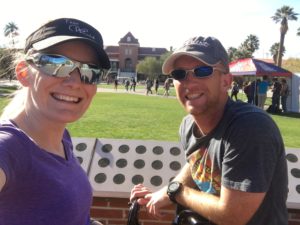 Not surprisingly, there is an app for this, and it sounds like it would have helped us avoid the kiosk-less docking station problem. If you purchase your day pass within the app, apparently you can get unlock codes directly from your phone, bypassing putting your credit card into a kiosk. Unfortunately while attempting to link our current passes to the app, we discovered that in order to create an account, you had to purchase some sort of pass at the same time. Not wanting to be charged twice for the day, we stuck with the kiosk method, but we suggest you download the app in advance and purchase your pass on your phone before beginning your TUGO excursion. Not surprisingly, there is an app for this, and it sounds like it would have helped us avoid the kiosk-less docking station problem. If you purchase your day pass within the app, apparently you can get unlock codes directly from your phone, bypassing putting your credit card into a kiosk. Unfortunately while attempting to link our current passes to the app, we discovered that in order to create an account, you had to purchase some sort of pass at the same time. Not wanting to be charged twice for the day, we stuck with the kiosk method, but we suggest you download the app in advance and purchase your pass on your phone before beginning your TUGO excursion.
Overall we were very pleased with our TUGO experience. Although they are heavy and a bit slow, the bikes are comfortable, docking and undocking is simple, and they are a pretty good value, especially if you live in the area, and you purchase a month or annual pass. If you’re looking to live near a TUGO station and take advantage of these bikes year round, here are the homes currently for sale within a quarter mile of a docking station.
January 26th, 2018
Have you heard about Cape Town’s imminent water shortage? The popular vacation destination in South Africa is expected to run out of water in the next few months. This is the stuff that nightmares are made of, especially for those of us that live in the desert. Though Tucson isn’t expected to run out of water anytime soon, it’s certainly a possibility in the future, and we need to start addressing it now so that we don’t find ourselves being limited to two minute showers, unable to refill our pools or wash our cars, and having to reuse water throughout the day, as is now mandated in Cape Town, all while waiting for the tap to be cut off in April. It’s tragic. They will be the first major city in the world to run out of water, but I doubt they will be the last.
After toilets and clothes washers (more on those in a later post), showers typically are the third most water hungry area of a household. Obviously the longer the shower, the more water is used. The Energy Policy Act of 1992 federally mandated a maximum flow rate for shower heads of 2.5 gallons per minute while the average flow rate is 2.1 GPM due to low flow shower heads, so a 15 minute shower could use up to 37.5 gallons of water. Even if you have a really old shower head, it’s still probably better than filling the bathtub which typically holds 80-110 gallons of water. Young kids typically take baths, but moving them over to showers as soon as possible has a huge water savings benefit if they can learn to take short showers. Plus there’s this…
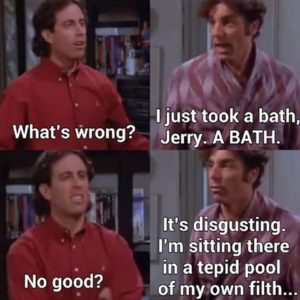
I know what you’re thinking: “I tried letting my child take a shower, and they spent FOREVER in there, barely doing anything.” That’s been my experience at least, and I suspect it’s fairly common given that kids tend to spend long periods of time in the bathtub…barely doing anything other than playing around unless directly supervised. Training them to take quick showers is a monumental challenge, and it involves a lot of reminders (nagging), instruction (orders), and limits (threats), depending on the night or your perspective. Shower time can become a trying time for both parent and child.
I’m a big proponent of letting technology be the reminder and the bad guy as often as possible, such as putting an alarm clock with an obnoxious sound across the room rather than checking and prodding your child every 5 minutes to see if they’ve gotten out of bed yet and are getting ready for school. I searched high and low for a device that would turn the shower off (or the hot water off) after a particular amount of time, and I found a device that has been extremely helpful.
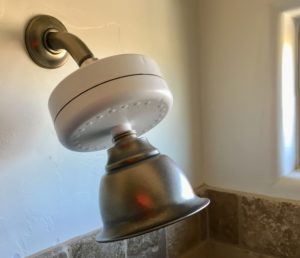
The Shower Manager can be set to allow 5, 8, or 11 minute showers by using a magnet to flip an internal switch. Hold onto the magnet (and don’t explain how it works), and your child won’t be able to switch it to 11 minutes. It connects to your existing shower head, and at T-minus 1 minute, it gives a warning beep before cutting the water pressure by two thirds when the time runs out. If they shut the shower off, full pressure will not return until after a 5 minute refresh period.
Our kids have responded extremely well to the Shower Manager. We teach them about the importance of water conservation so they understand the need. They have never complained that the managed showers are too short, but boy did they used to complain when WE would tell them to get out (“but it’s so waaarm!”). We still have to check occasionally to make sure they’re actually washing and not just standing under the warm water for 5 minutes, but that comes with the territory of being a parent. Shower time is no longer a battle, and we’re creating good habits and saving water for the future.
December 30th, 2017
I’ve been hearing rumblings for a while now about the need for homeowners to install solar panels ASAP because of impending changes from TEP, but of course I was skeptical that this was just a ploy from the solar installation companies to get more business. So after a class at the Tucson Association of Realtors about residential solar power that explained why the need for haste, I decided to dive in deeper and request home visits to get proposals from two different companies for our house: Technicians for Sustainability (local) and Tesla (formerly Solar City).
Why Solar?
Obviously getting your energy from renewable sources like wind and solar is better for the environment than getting it from fossil fuels. You can significantly reduce your carbon footprint by installing a solar photovoltaic (PV) system on your home.
The drastic reduction in your electric bills will pay off a purchased solar PV system in about 8 years for most homes, but the system will continue to generate electricity for free for close to 30 years. Even a leased system, which will be discussed later, fixes your monthly electric bill somewhat below your current monthly average.
Why should I install it now?
Currently homes with solar PV systems benefit from TEP’s net metering program, but the Arizona Corporation Commission has directed utilities like TEP to replace net metering with a new energy export rate. Unfortunately, we don’t know when that will happen exactly or what the new energy export rate will be. All we know is that it will likely be early in 2018, and the loss of net metering will make solar much less appealing for new solar PV owners. The good news is that anyone who has a contract signed with TEP before these new rates go into effect, including those with panels already on their homes, will be grandfathered into the current net metering system for 20 years.
January 2018 Update: The deadline for getting grandfathered into TEP’s net metering for solar PV systems has been extended to July or August. That’s when you need to have a contract signed, not have the panels installed yet.
What is net metering?
Net metering “allows residential and commercial customers who generate their own electricity from solar power to feed electricity they do not use back into the grid” (Solar Energy Industries Association). This means that when your solar PV system is generating excess electricity during our sunny Arizona days in cooler months, it is sending that electricity back to the grid, and TEP is keeping track of this in a virtual account that you can draw from later, such as at night when your solar panels are not generating any electricity.
Net metering eliminates the need for batteries to store your excess energy for later use (a huge expense with a lot of maintenance). The utility company tracks it for you year round, allowing you to bank lots of extra energy in the fall, winter, and spring and then draw from that excess in the summer when your electric bills are usually the highest. A good solar PV system will be designed specifically for your home to get you through the year with just the right amount of energy.
What tax credits are available?
There is a federal tax credit for 30% of the total installation cost which will begin to reduce below 30% after 2019. An Arizona state tax credit for $1000 is also available. The trick is that you must have tax liability to take these credits as it is a not a refundable credit, but unused credit can usually be rolled over into future years.
What are my payment options?
You have three options for paying for your solar system: lease, purchase, and finance.
Leases have been the most popular option because there is no up front cost to the homeowner BUT these systems are not recommended for most people anymore because they can make the home difficult to sell, and they provide very little financial return. A home buyer would need to qualify not only for their home loan but also for the lease, and at the end of the 20 year lease, the system would be removed or the lease could be renewed.
Leased systems provide you with a fixed electric bill each month which is less than your average monthly bill, but it’s not a whole lot less, and if you’re not planning on staying in your home for a long time, it may not be worth the hassle when it comes time to sell. Leased systems may be good for people who don’t have tax liability (the installation company takes the credits instead and passes the savings on to you) and are going to be in their home for a good while. Even Solar City / Tesla, the king of leased solar systems around town, recommends leased systems mainly for retired folks nowadays.
Purchasing your system outright provides the greatest return on investment, allowing you to recoup what you spent in about 8 years or less. After your initial outlay, your electric bill each month will essentially just be for the base TEP fee, which would be about $20 for us. An owned system will transfer to a new owner as easily as your oven would, and although appraisers do not value it for nearly as much as you will spend on it, a good agent will tout its value to potential buyers. Near nothing electric bills should be worth a bit of a premium, right?
You can also get financing to help purchase your system outright which gives you the benefit of complete ownership, easy transfer to a new owner (though requiring you to pay off your loan), and a better return on investment than leasing though not as good as purchasing with cash. Financing can be done through a local credit union, a home equity loan, or another financial institution recommended by the installation company.
Will it work on my roof?
The best place to put your solar system is on your roof. It gets very expensive for the installation company to also have to engineer a new structure or a way to secure it to the ground. In order to be the most efficient, solar panels should be installed on a south facing roof, with the west being the next best place. It should also be virtually free from shade from other structures or trees.
Panels can be installed flush on pitched roofs or at an angle on flat roofs. The angle should be big enough and the rows of panels should be far enough apart that your flat roof can still be accessed in order to be recoated as necessary without having to remove the panels. A good installation company will install them directly into the rafters of the home so that they are very secure and won’t blow off during a severe storm.
Will the solar panels last?
Solar panels from Technicians For Sustainability come with a 25-year manufacturer’s warranty on the panels, a 10-year guarantee on all other parts (excluding the solar equipment) and labor, a 5-year power-production guarantee, and a 10-year warranty on the inverter. Unfortunately, the inverter will likely need to be replaced outside of that warranty period, at about 15 years, and that can be several thousand dollars or more of expense. Other than that though, there should not be any expenses after the initial installation. Panels do not require regular maintenance or cleaning, and TFS monitors them remotely for any failures. They are expected to perform well for 25+ years with only about a 0.6% degradation in power production per year depending on the type of solar panels used.
Solar City / Tesla offers a 20-year system warranty. They will also replace your first inverter for free, although the relative cost compared with TFS seemed to have this expense built into the Tesla pricing. If you lease panels through them, they will restore your roof after the end of the 20-year lease term for free. Like TFS, Solar City / Tesla also monitors the panels 24/7.
Who should install it?
Ultimately we decided to go with Technicians for Sustainability for one main reason: they gave us three different proposals based on panels from three different manufacturers: LG, Hanwha, and Sunpower, while Solar City / Tesla does not tell you who will be making the solar panels. You get whatever is available at the time, and that is after you have signed a contract with them. It was important to us to be able to choose.
Also, the Solar City / Tesla proposal was within a couple hundred dollars of the proposal we chose from TFS, but it would only generate 84% of our energy as opposed to 98% with the TFS panels (made by LG), and that was also with more panels on our roof than the TFS design. That initial design was also done with a satellite view of our roof by the Solar City / Tesla rep, while the TFS rep went onto our roof himself to measure and scope out where the panels could go.
We’re also a fan of local companies and we have numerous friends who installed solar through them and have been very happy, so TFS is the obvious choice for us, but there may be reasons why another company would work well for you. For example, TFS cannot install our panels until April, while Solar City / Tesla said they could do it as early as January or February. Regardless of which company you decide to go with (and there are quite a few in Tucson), it’s probably a good idea to get proposals from more than one. I’m certainly glad we did. Just do it quickly, because you’re running out of time to be grandfathered into the current net metering! Remember, the solar panels do not need to be installed before TEP changes their rates, but you do need to have a signed contract for net metering with TEP before that time.
Read our follow up post about the installation process, data monitoring, and what happens when solar just doesn’t work for your home.
November 18th, 2017 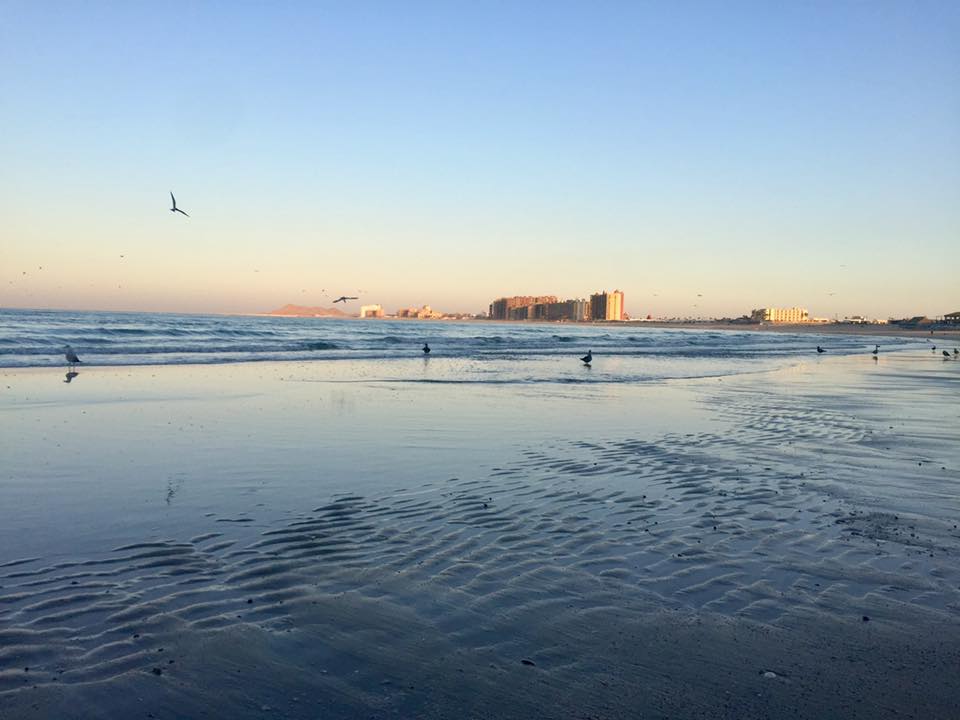
You won’t find any beachfront property in Arizona, save the shores of the Colorado River in Lake Havasu perhaps, yet we Arizonans love to beat the heat with a nice trip to the ocean once in a while. A six hour drive away, San Diego is probably the most popular destination for this, but we have an even closer option, albeit in a different country, with Puerto Peñasco, México being only four hours away.
A Little History
Puerto Peñasco translates to Rocky Port, though we call it Rocky Point. It was given the name Puerto Punta Peñasco (Port Rocky Point) in the 1930s when a railroad and fresh well water finally established it as more than just an area for itinerant fisherman. Eventually the Mexicans dropped the Punto (Point) while the Americans dropped the Port (Puerto). Oops. Nowadays Rocky Point is home to about 60,000 people, many of whom are from the United States and other retired expats.
Rocky Point is not a particularly historic destination filled with Mayan or Aztec ruins like many places further south in Mexico. Keeping in mind its fairly young history, don’t plan on visiting any museums or climbing any ancient pyramids, but do plan to enjoy good food, relaxation, and some fantastic beaches. Located at the top of the Gulf of California which is between the Baja Peninsula and mainland Mexico, Rocky Point’s primary industry is fishing. We saw upwards of 20 fishing boats at a time out in the water for most of the day. It’s also a very arid place being in the Altar Desert, so it doesn’t have that humid ocean feel or smell, at all.
Getting There
The easiest way to get to Rocky Point from Tucson is to head south on I-19 and take Ajo, which is Highway 86, to the west. It’s a two-lane road with little to see along the way. You do pass by the base of Kitt Peak where you can easily see the observatory perched up top. When you get to Why, Arizona, take a left (south) onto AZ-85. This means you will not go through the town of Ajo. The next stretch goes through Organ Pipe Cactus National Monument, taking you to Lukeville at the international border. 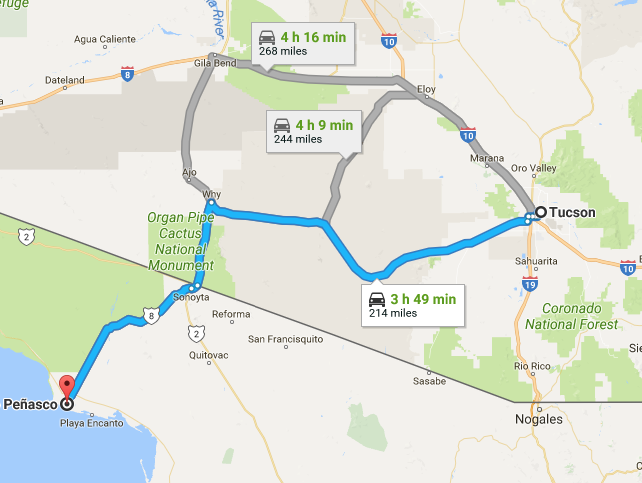
You do not need to show a passport to enter Mexico, but you’ll need it on the way back. You’ll also need Mexican car insurance which is in addition to your standard car insurance. You can buy it online for the amount of time that you’ll be in the country. We went through our friend Don Cox with Farmer’s Insurance. He took our info over the phone, emailed us the paperwork to sign, scan, and email back, and we had it all taken care of in about an hour with the added peace of mind knowing that we were getting it from someone we trust and someone who would have our back if something happened while we were there. His rate was right there with what I found online, about $50 for the three days (it’s by the hour, not the entire day).
Once you cross the border, you will be in Sonoyta, Mexico, which is a small border town with excellent signage pointing you towards Puerto Peñasco. No need for a map. You won’t get lost. Just follow the speed limit, which is low and in kilometers. In fact, follow ALL of the laws while in Mexico if you want to stay out of trouble. Once you’re out of Sonoyta, the speed increases, though not as much as you may like. You’ll notice the signs are riddled with bullet holes. Not exactly a welcoming trait. It’s recommended that you avoid driving at night, which I can understand in this open stretch of land, but there were plenty of cars going both directions during the day time, and we didn’t have any problems. This area is safer than most areas of northern Mexico for tourists, so don’t stress about it. You’ll be on this same road all the way into Rocky Point.
Sandy Beach
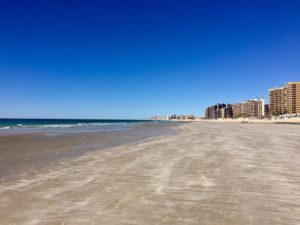 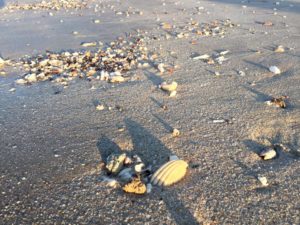 
Perhaps the most popular of the beaches in Rocky Point is Sandy Beach, lined with high rise condos, many of which are currently under construction as it continues to grow. Sandy Beach sits at a short distance from the rest of town, with a golf course found immediately behind the condos, and nothing but desert behind that, save one single modern windmill, generating some electricity for an unknown entity alone in the desert. The beach is vast, mostly free of rocks, and shallow for a long way out to sea. There are few areas that are rocky, and you may spot a live crab or other sea creature in them. Seashells are very common, and you won’t get tangled up in any seaweed. All in all, this is a great beach, much better than those of southern California.
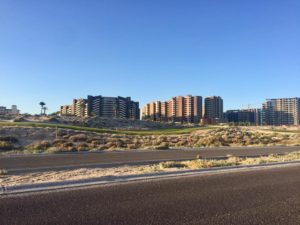 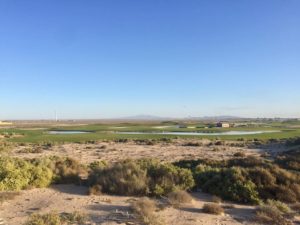
Look west towards the end of Sandy Beach and you will find a long man-made structure jutting out into the water, consisting of enormous cement blocks piled on top of each other. This is the future port for cruise ships, expected to be up and running in 2018. Currently sitting in what feels like a very isolated spot, the bar and restaurant Wrecked at the Reef is situated right at the end of this dock. We had amazingly fresh fish and chips there while sitting outside with our feet in the sand under a palm frond umbrella among a plethora of seating options for groups of all sizes. It was a weekday, but you can tell that this place is hopping during high season, with its beach volleyball court, sports bar feel inside, area for live music and dancing, fire pits, and outdoor games.
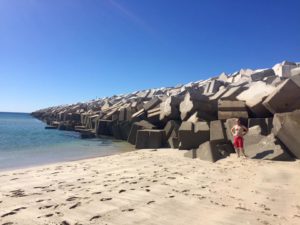 
Playa Hermosa
It’s about a 3.5 mile walk along the beach from Wrecked at the Reef and the future cruise line hub to Las Gaviotas Condominiums where the beach meets the town. Somewhere along this walk, Sandy Beach transitions to Playa Hermosa where the condos are located. We were very happy with the accommodations and especially the location. Walk one direction and you’re headed down the beach towards the high rise condos. Walk the other direction, and you’re in town, likely to get ice cream at the Thrifty just a block away. The condos had secured parking and a guard on duty 24 hours to open and close the gate for you. The only time I had to speak Spanish the entire time I was in Rocky Point was to speak with the guard when we first arrived in order to clear up confusion about getting our key which was not there due to a miscommunication. Our condo was older than all those high rises, but plenty sufficient for a great stay.
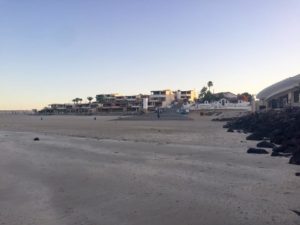 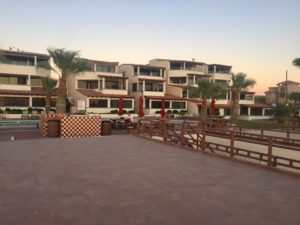 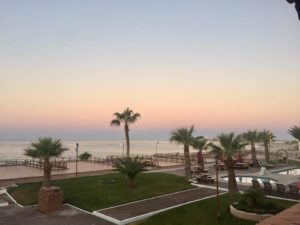
Calle 32
Head North to Calle 32 and you’ll find the “Rodeo Drive” of Rocky Point. This tourist destination is a single street lined with shops and a few restaurants. It was surprisingly relaxed compared to the other major tourist attraction in Rocky Point, Old Town or El Malecón, or as our American waitress called it the first night, Downtown. None of the vendors came out to try to sell us their wares on our way to lunch on Calle 32, and a lot of what they had out for sale looked like high quality crafts, not just tourist junk, although there is plenty of that too. We ate at Mariachis y Tequila, a highly rated restaurant on Yelp that felt pretty authentic though the clientele was exclusively retired Americans. The bartender who seated us did not speak much English, but the waiter did. The food was pretty good but not amazing.
El Malecón
The “downtown” area of Rocky Point is situated southeast of Sandy Beach on a small peninsula next to the port. This is where the fish market is located. We drove through the main drag and were immediately accosted by men trying to entice us to eat at their restaurants, but we kept going, to the far end, where we parked and ate at the Satisfied Frog, a restaurant that is also highly rated on Yelp. It’s an amazing location, with large windows looking right down onto the coast below where you can watch seagulls and pelicans do things that sea birds do. The view of the ocean and the high rise condos of Sandy Beach in the distance make up for the average food, a mix of Mexican and American fare. The best item we had was the cheeseburger which was raved about on Yelp by many people. They were correct. It was fantastic.
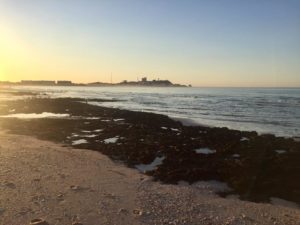 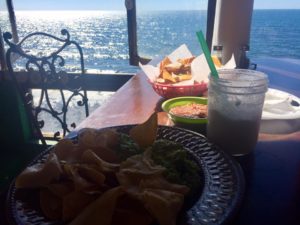
Las Conchas
Another area of Rocky Point worth knowing about is Las Conchas, which is the gated community of homes along the beach, primarily owned by Americans. I’ve stayed there before, and it’s quiet with a fantastic beach, but if you want to get to bars and restaurants easily, it may make sense to stay closer to town, on the east end of Sandy Beach, because a stay in Las Conchas requires a drive anytime you need something. Las Conchas is also home to the CEDO Institute (Centro Intercultural para el Estudio de los Desiertos y Oceanos) which has a free nature talk at 2pm on Tuesdays.
Although we arrived in Rocky Point unsure as to what to expect, we left feeling refreshed and expecting to come back in the future. If you’re hankering for a trip to the beach, definitely consider this hospital Mexican town!
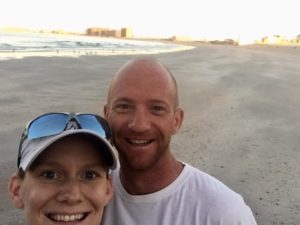 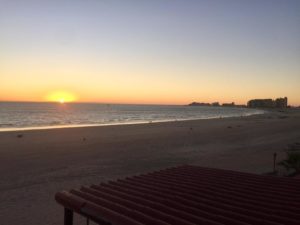
October 19th, 2017 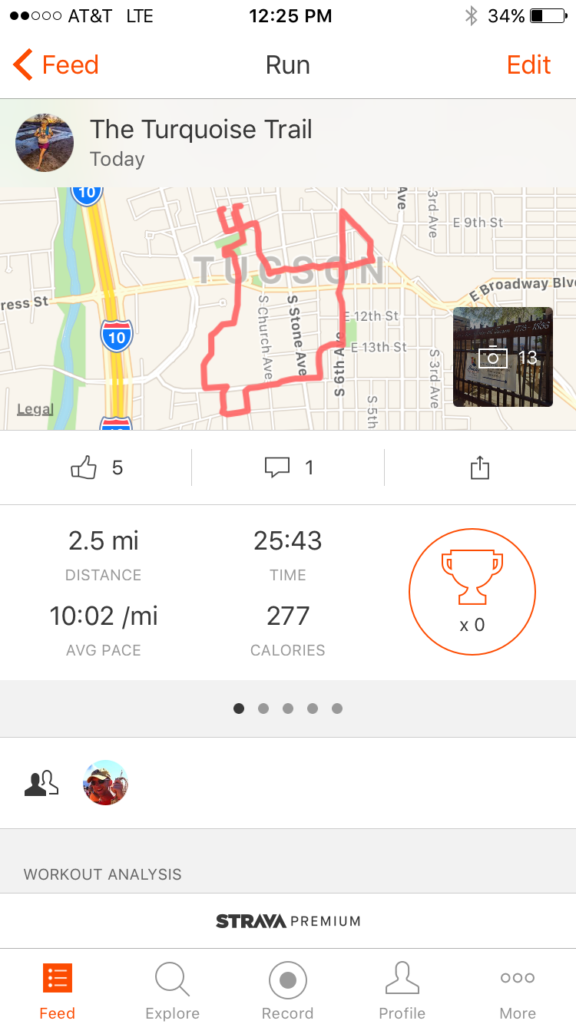
I’ve lived in Tucson my entire life, but other than what I learned in 8th Grade about Tucson and Arizona history, sadly I don’t know much. Nor did I really care to, until I read Nancy E. Turner’s historical fiction novel These Is My Words, written in the style of a young woman’s journal in the late 1800s in and around Tucson. This brilliant book references Ft. Lowell, Hotel Congress, St. Mary’s Hospital, Pennington Street, and other Tucson landmarks, some of which I had never heard of before, including “lung asylums” because Tucson was a mecca for tuberculosis treatment due to the “curative” powers of the sun. When I finished the book over just a couple of days because I couldn’t put it down, I suddenly had a desire to know more about my city.
Googling up a storm, I came across the Turquoise Trail, which is literally a turquoise line on the ground that you can follow from historic landmark to historic landmark throughout downtown Tucson. Formerly called the Presidio Trail, I had always thought it was related to Monday’s Meet Me at Maynard’s running/walking path. In similar fashion, Stephen and I decided to liven the pace of our tour a bit and run between landmarks.
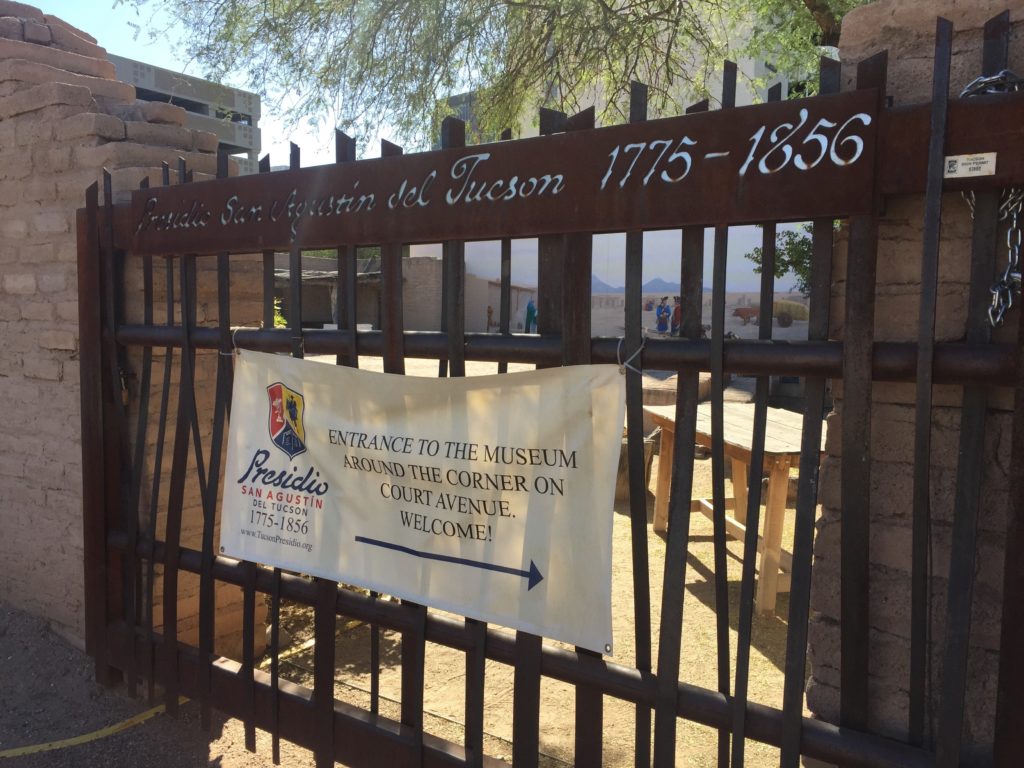 #1 – Presidio San Agustín del Tucson Museum The trail starts at the Presidio San Agustín on the north end of downtown Tucson. We parked on the side of Church Avenue just after turning onto it from 6th Street. Parking here is free, so we pulled over right away and took an additional little walk through the cute homes on Court and Meyer Avenues. The Presidio is on Washington Street between Court and Church. Look for the turquoise circular “1” on the sidewalk near the gate pictured here.
Although you can pick up a map at the Presidio Museum or the Tucson Visitor Center, I just saved it as a photo on my phone in advance and zoomed in at each point to read about the location. Notice that there are some places described on the map that don’t have numbers and therefore are not directly on the Turquoise Trail. If you want to get the full experience, make sure to look ahead for those landmarks and be willing to venture off of the trail a bit rather than just following it until you arrive at the next number on the ground.
The turquoise line meanders 2.5 miles through downtown Tucson, sometimes with very short distances between landmarks (mostly statues near each other). Each place has a placard describing the location and a similar description to read from the map. I suggest you read both, as they do have overlapping but also different information.
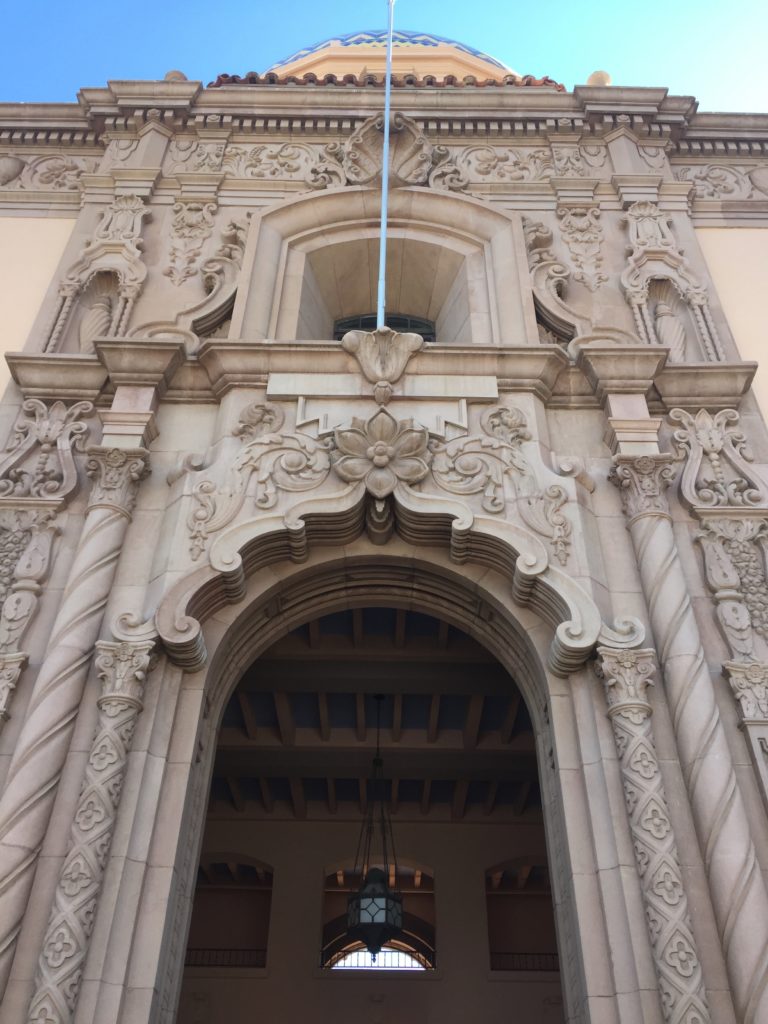 #2 – Pima County Courthouse 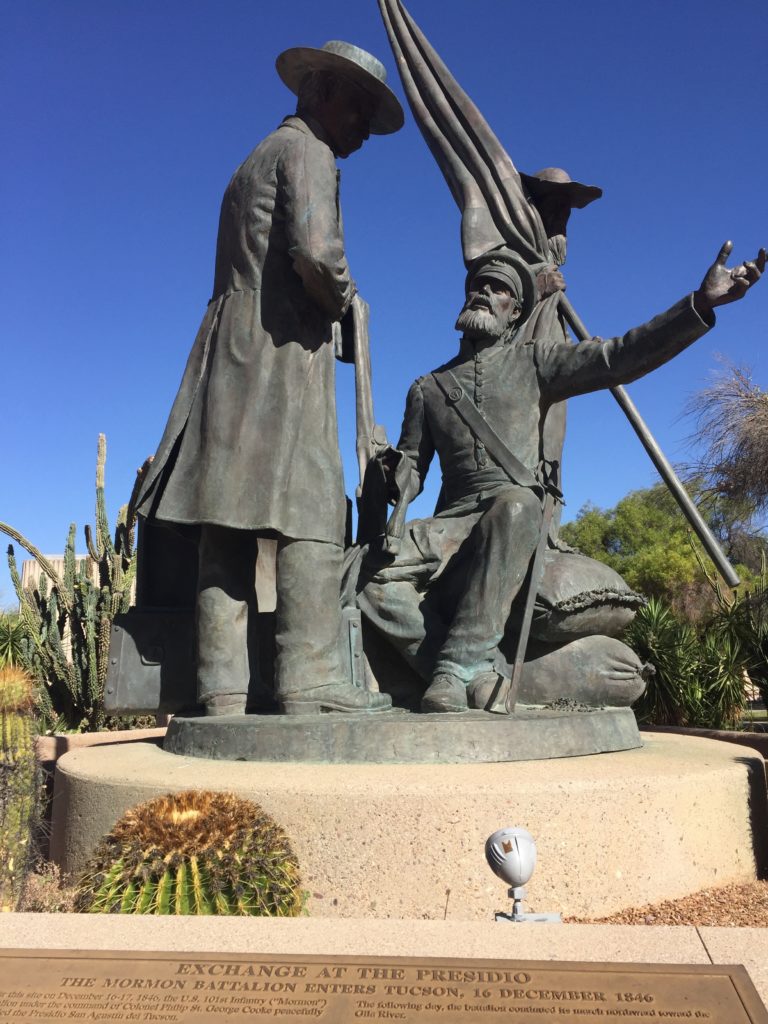 #3 – Mormon Battalion Sculpture 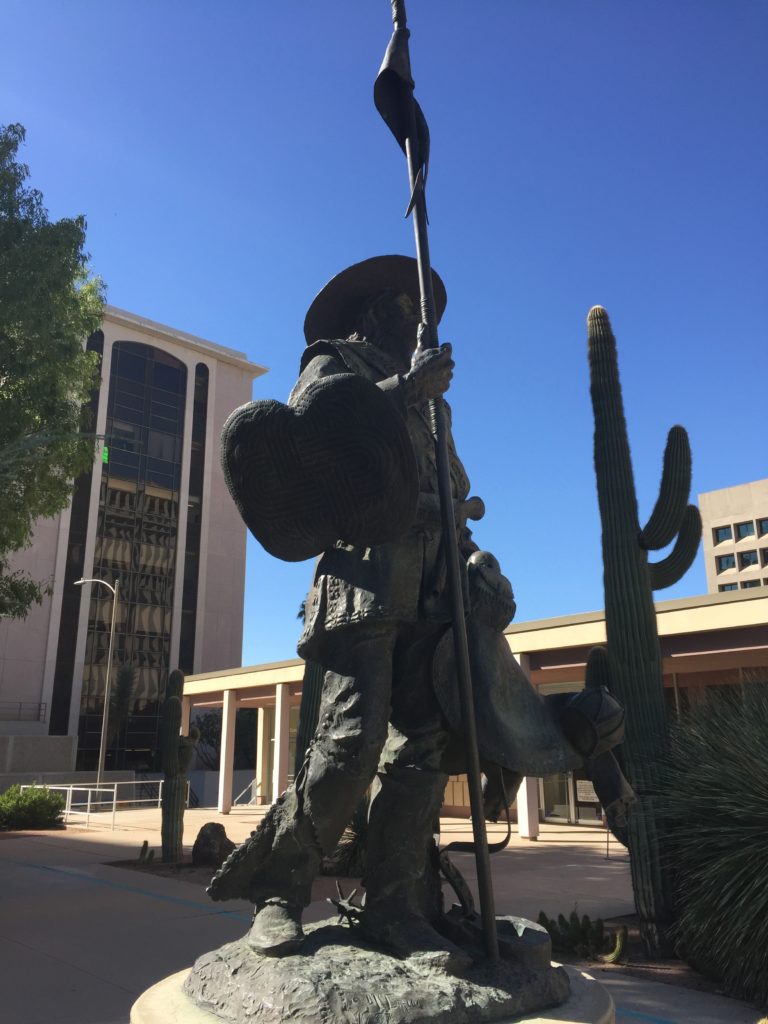 #4 – Soldado de Cuera (Leather Jacket Soldier) Sculpture
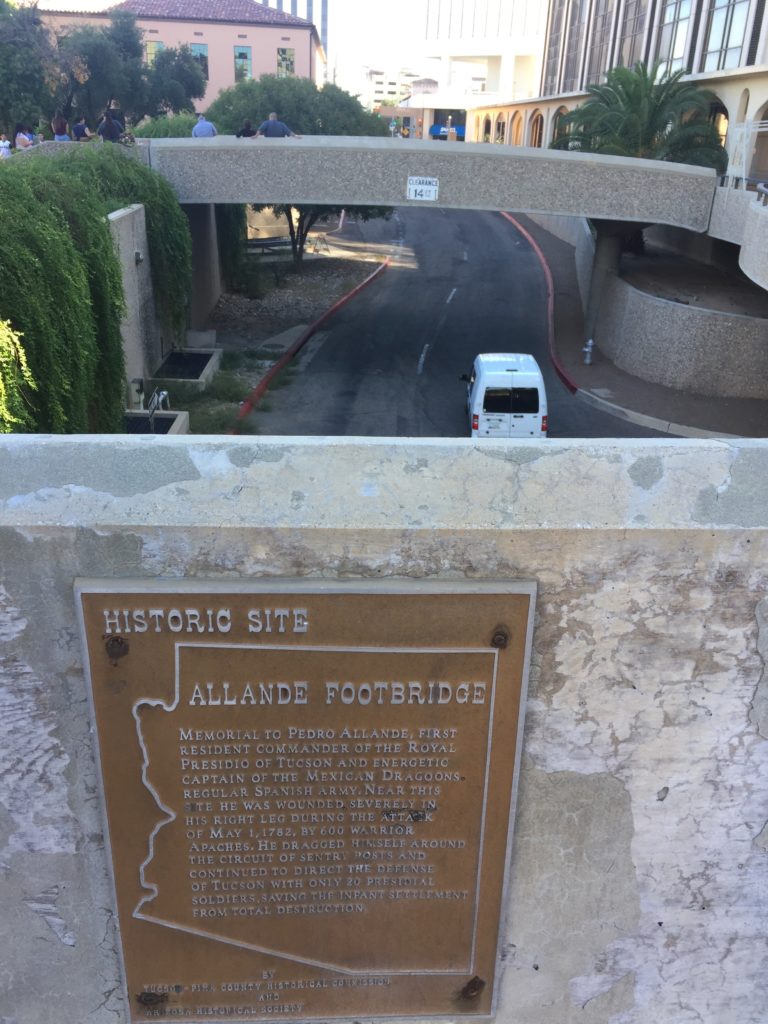 #5 – Allande Footbridge 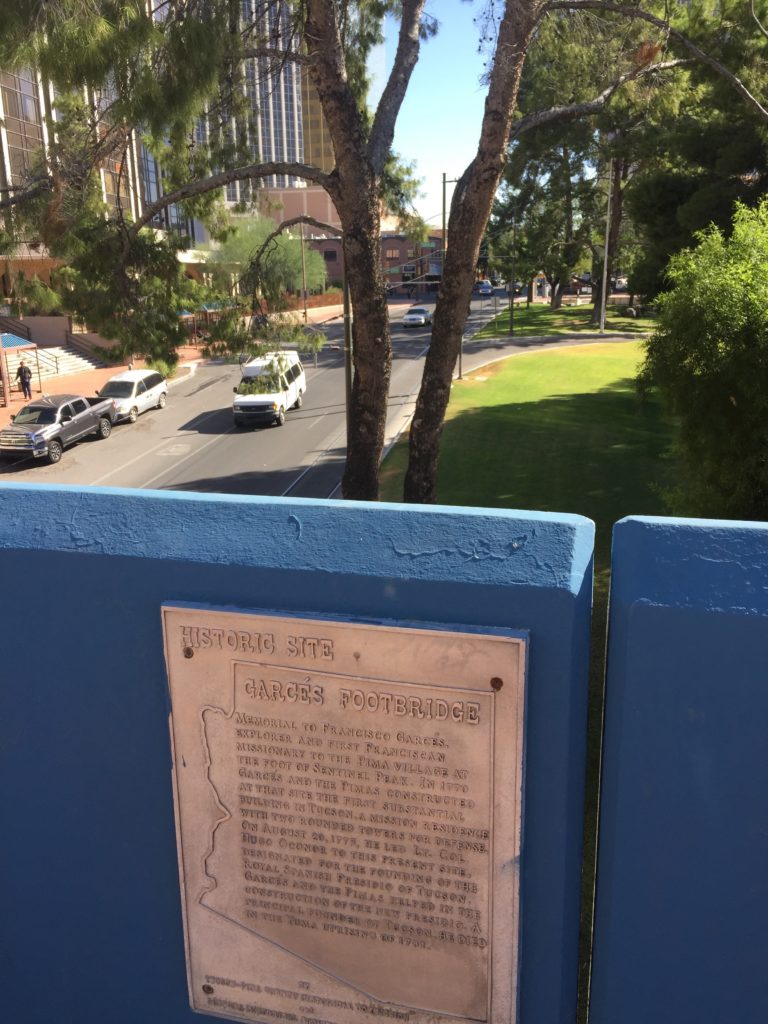 #6 – Garcés Footbridge 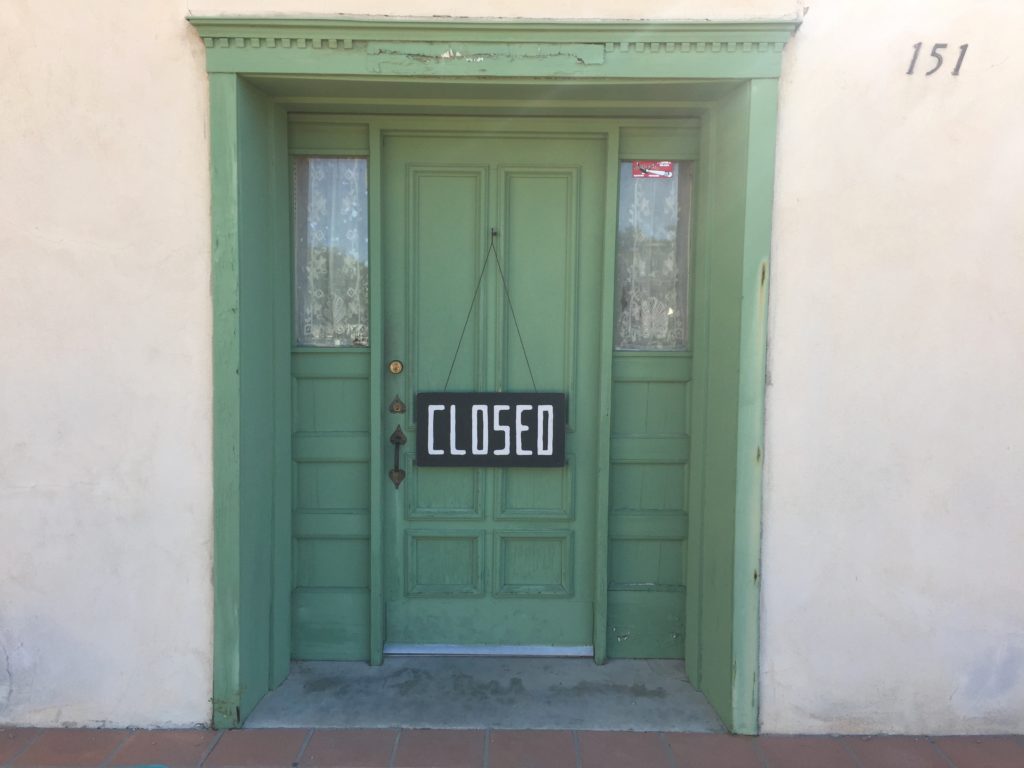 #8 – Sosa-Carillo-Frémont House
One of the highlights of the tour for me was discovering the location of Carillo Gardens, a place visited a few times by the characters in These Is My Words, and a place I had never heard of nor could imagine in historic Tucson. Carillo Gardens was Tucson’s first public park, with 8 acres of lush landscape, duck ponds, a restaurant, saloon, circus, zoo, and live music, a festive place to hang out in the 1800s. We also visited El Tiradito which is a tucked away shrine dedicated to the victim of a tragic love triangle, and we saw a flag pole that has been standing since the 1700s. Given all of the massive amount of information imparted on this tour, it is definitely worth a second visit. Next time perhaps we’ll slow down and walk it.
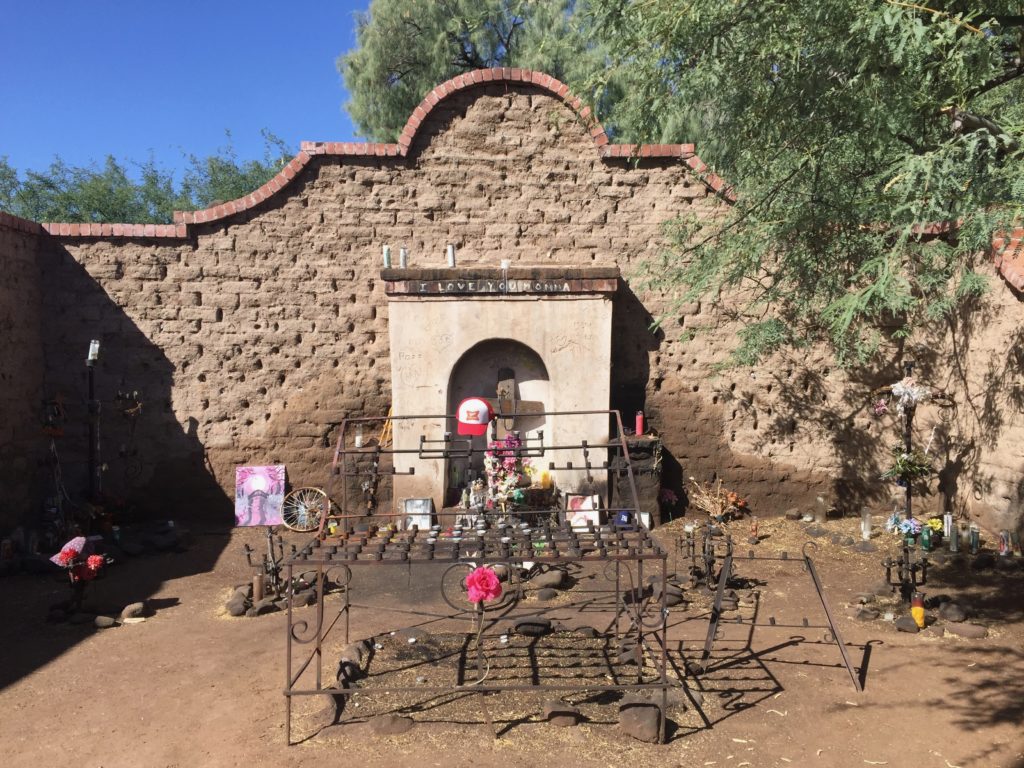 #10 – El Tiradito (The Castaway), also known as The Wishing Shrine 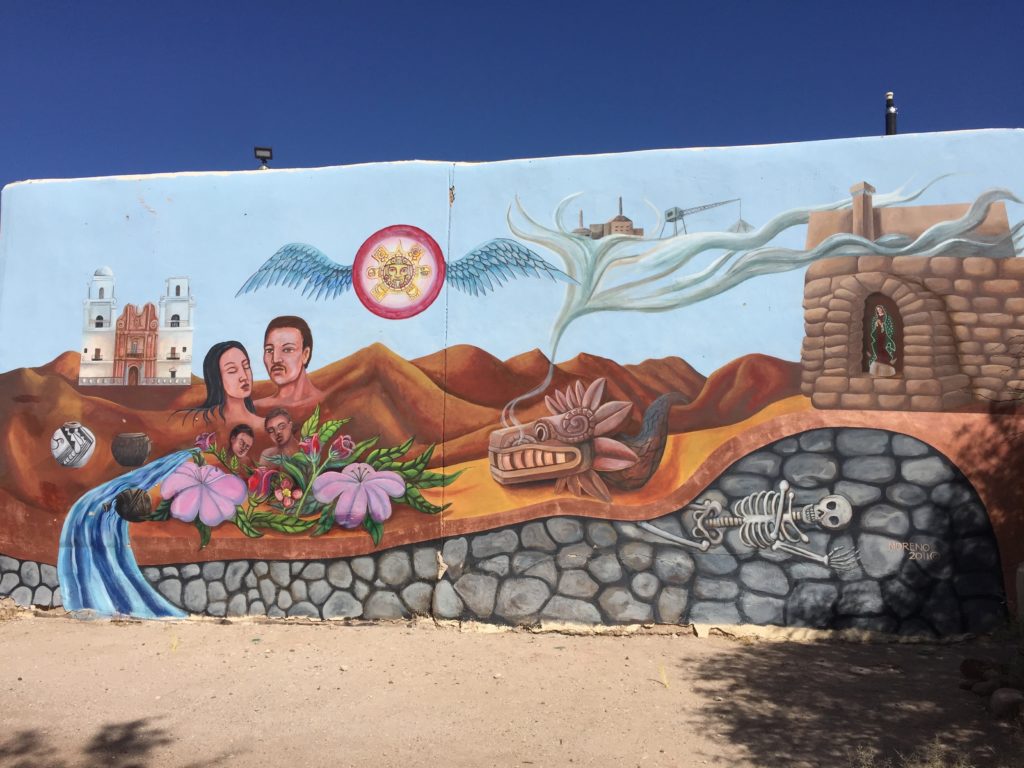 #12 – Rosendo S. Perez Park
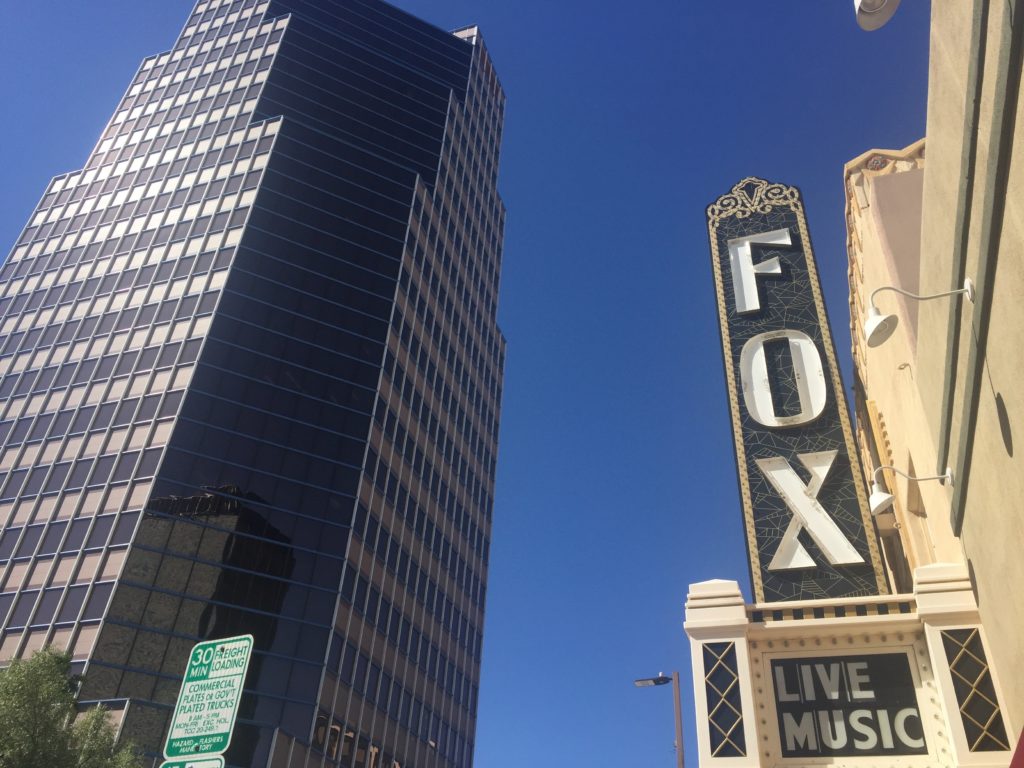 #21 – Fox Theatre 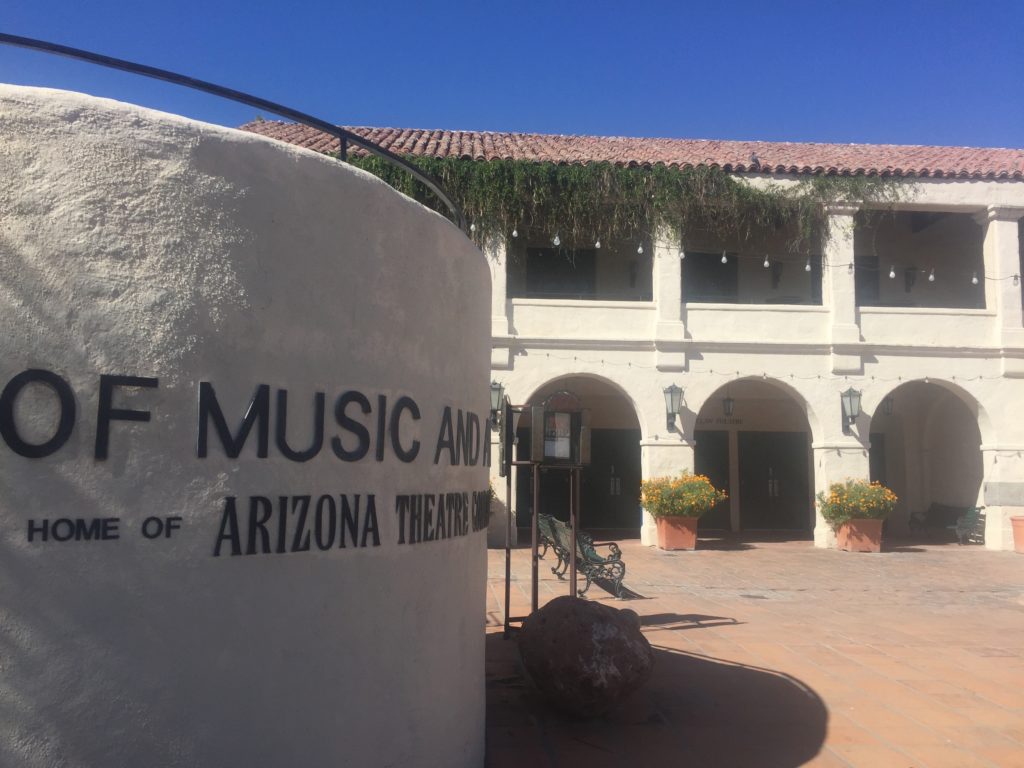 #16 – Temple of Music & Art 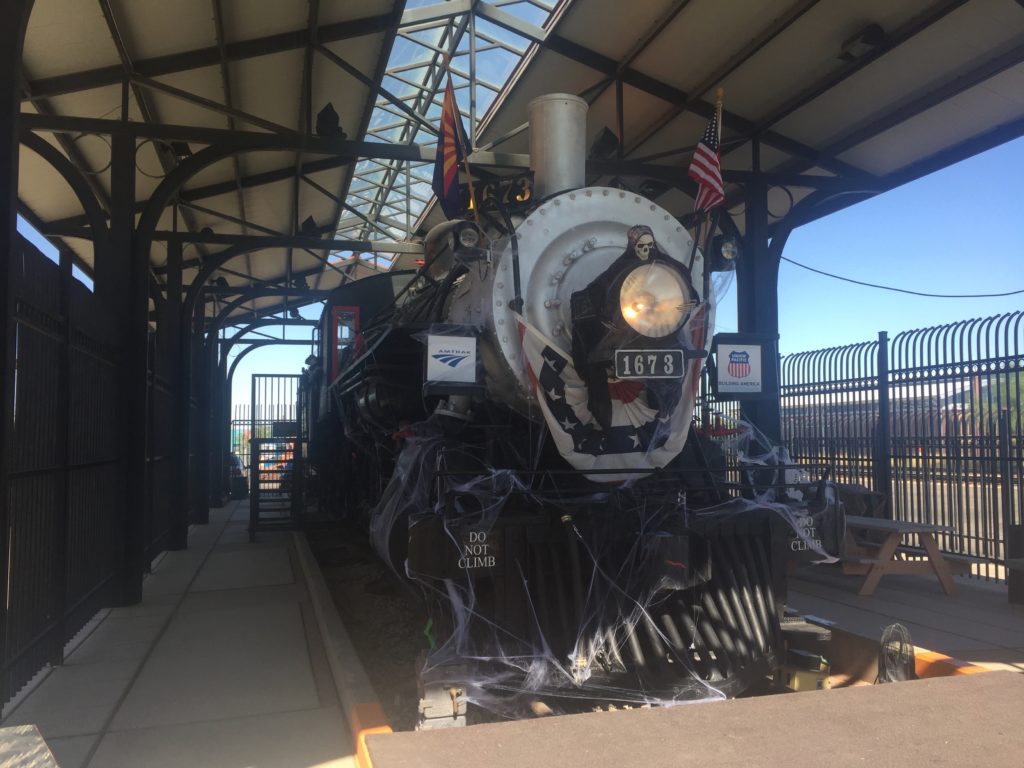 #20 – Historic Railroad Depot
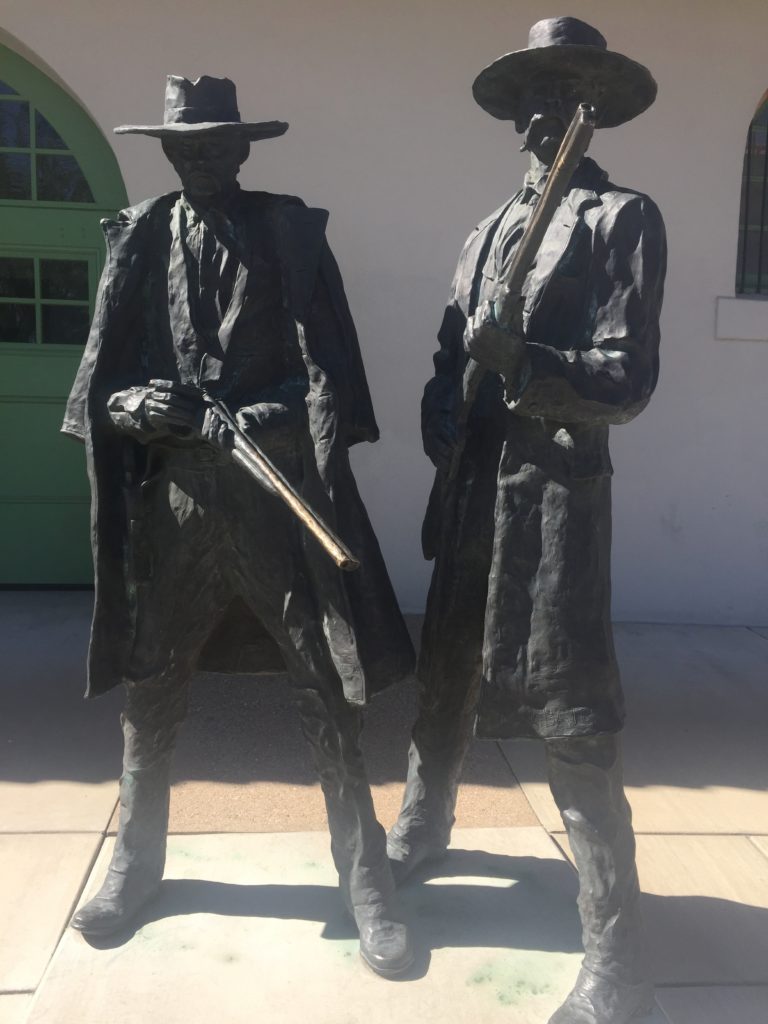 Wyatt Earp & Doc Holliday Statue
October 11th, 2017
This is the seventh in a series of articles targeted towards potential home buyers looking at building a custom home and the topics or questions they might face. Read the last article: Don’t Be Afraid of a Septic System. While these articles will focus on the typical issues of building a custom home in the Tucson, Arizona metropolitan area, many of the issues may well be similar throughout the state and other parts of the country.
Many buyers looking at building a custom home are financially positioned to make the purchase of the land using cash. However, sometimes circumstances make lot financing a more attractive or reasonable route so we’ll talk about a few of the possibilities. First, buying with cash is absolutely the easier way to go and provides for a stronger offer which can save on the cost of the land acquisition itself. Not only is it possible to negotiate a better price with cash but it can also avoid the costs of originating the loan, thereby saving some extra money. When practical this is the route we do recommend for lot buyers. Even if financing is obtained for a construction loan the value of the lot purchased with cash is often used towards the down payment needed on the construction loan.
Seller Financing
Should circumstances require financing for the lot, there are a number of options available. Often the least expensive financing option is through seller financing. Not every seller will be able to, or want to, offer a seller carryback, but this type of financing avoids the hassle of dealing with a traditional lending institution and many of the upfront costs to originate the loan. In a seller carryback title to the property is transferred to the buyer who becomes the legal owner (assuming all tax & HOA payments), and the seller acts as a lender who will receive recurring payments, typically monthly, which are channeled through an escrow company. Seller financing does require a sizable down payment to be made by the buyer at closing which goes to the seller who must pay typical closing costs. The remaining amount is financed for an agreed upon period, but often this is is reasonably short term, perhaps 3-5 years.
The exact terms of the seller carryback are negotiated and these may include: interest rate, length of the loan, amortization of the loan, lien position, payment intervals, whether it’s interest only or interest & principal, and if there’s a balloon payment. Balloon payments are a pre-determined time period at which the balance of the loan is then due, recommended to be at least 2 years from origination. Since it’s typical that a carryback is amortized over a longer time period the monthly payments are usually smaller, but since the seller doesn’t want to wait for 20-30 years to receive the money, a balloon payment is put in place.
Additionally, the escrow company will set up a promissory note and deed of trust in favor of the Seller, meaning if payments aren’t made the seller can foreclose and take back the property per state statutes. While it’s another negotiated term it’s common that an impound account is set up to handle real estate taxes and hazard insurance payments. This protects the interest of the seller offering the financing. One of the other key points is whether the carryback can be subordinated to a construction loan, the negotiation of which is not on the seller financing form but on the vacant land purchase contract. If this is not agreed to by the seller then the buyer must wait to pay off the carryback before starting construction with financing or obtain additional financing to pay off the seller carryback in full. Seldom will a seller providing financing agree to subordination as it moves them to second lien position. This is an overview of the terms on the seller financing forms, and overall it’s a much simpler process than bank financing even if it sounds complicated.
Loan Options in Tucson
Obtaining a lot loan from a bank or credit union would be the next most popular option. Not every lending institution offers lot loans though so choices will be much more limited. Typically a bank or credit union will require at least 20% and many times 30% down payment on a lot loan. Again, the options available for lot financing are severely reduced since many lenders don’t offer lot loans. Two of the more popular options locally are Washington Federal and OneAZ Credit Union. At Washington Federal we recommend Dannielle Andrade as a loan officer and at OneAZ Janinne Grimes. Both of these loan officers are experienced with lot loans and can give you current rates and terms. They’ll both offer construction financing as well, so speaking to them is a good idea if a buyer is considering either a lot loan or construction financing. Other institutions offering lot loans or construction financing include Mid-First Bank, Vantage West Credit Union, Bank of the West, and National Bank of Arizona.
At the time of the writing of this article Washington Federal’s lot loan program required 30% down and was a fixed rate 20-year loan or a shorter term 2-year loan with interest only that can be rolled into an All-in-One Construction Loan. At OneAZ the down payment required is 25%, 3-year or 5-year term, fixed rate up to 5-years, amortization over a 25-year period, and can be up to $500,000. Again, these programs can change and have additional details so please contact the loan officers directly to get more information so you can find the right fit.
Private Money Mortgages
The last and honestly least attractive lot financing option is through a private money mortgage, also referred to as a hard money lender. These are simply private individuals who offer financing, typically to investors, for very short-term periods and at much higher rates. Most private money loans are 6-12 months and rates can range from competitive with banks to over 5% higher. They’ll also commonly have a steeper origination fee, adding another layer of expense. It’s almost always more costly to get money from a private money lender, so it’s a last resort and only advisable in very special circumstances.
If lot financing is something you need in order to begin the journey towards your custom home, please let us know if you need additional guidance. Hopefully now you’ve obtained a better understanding of lot financing options and we can provide additional information if you need further help.
Next up in our series of articles on custom home building will be: Wrapping It Up & How to Proceed.
September 6th, 2017
This is the sixth in a series of articles targeted towards potential home buyers looking at building a custom home and the topics or questions they might face. Read the last article about Wells & Water Issues in Tucson. While these articles will focus on the typical issues of building a custom home in the Tucson, Arizona metropolitan area, many of the issues may well be similar throughout the state and other parts of the country.
Not every aspect of building a custom home is exciting. In fact, some parts can be downright shi%*y. All “bathroom” humor aside, wastewater removal for a home is a consideration when choosing a lot and going through the build process. If given the choice, most people would absolutely choose to be connected to a sewer system and many custom lots are, but it’s also not a deal breaker for most people to utilize a septic or alternative system. Septic systems have been around for years and years and if installed & maintained correctly should provide decades of use with few issues. When septic isn’t an option, an alternative system may be used, but they’re often more costly and require more maintenance.
In Search of a Sewer Connection
During the lot purchase process definitely investigate and determine if the property you’re buying has an available sewer connection. Don’t rely upon the listing information alone, but visually confirm this, and you can also speak with the wastewater company to verify the connection. GIS maps online can be another resource to provide additional assurance. If the property isn’t connected or nearby access doesn’t exist, then a septic system will be you’re likely next step. At this point make sure the builder you’re considering hiring has experience with installing them. Most builders who’ve been around for a while should be very familiar with all the considerations of septic systems and have a reliable subcontractor who they consistently use and trust. During the due diligence process, or inspection period, research the property with the Arizona Department of Environmental Quality or Pima County Department of Environmental Quality to make sure it qualifies for a conventional septic system. Don’t rely upon other nearby homes having them and assume anything.
A septic system installation does add some additional expense to the build project, but the overall impact is pretty low with average installations running about $6,000 – $8,000 for a conventional system total installation. A general range of pricing for the septic system might be $3,500-$4,000, the leach field installation $2,000-$2,500, and the percolation test, design, and permitting another $700-$1,000. Alternative systems are generally more expensive and often require more maintenance costs and time spent monitoring.
Testing the Soil
Before a new system is installed a percolation test (or “perk test”) must be performed at the property which determines the native soil’s ability to treat and remove liquid effluent. This will indicate the soil condition at the property and the required size and location of the leach field where the effluent will be discharged into. The percolation test and system/site design should be completed by a licensed investigator to comply with governmental standards. An engineer is typically not required unless the construction costs will exceed $12,500. Once the perk test & site investigation report and design are completed, they can be submitted for approval to PDEQ with the “Notice of Intent to Discharge” form. After review and approval, a Construction Authorization will be received and the installation can begin. Inspections will be needed to verify proper installation before backfilling and getting the final Discharge Authorization.
While most of Arizona is governed and certified through the ADEQ, Pima County does handle their own records, testing, and certification so those throughout the greater Tucson area can get more specific information from the Pima County Department of Environmental Quality. Most of their guidelines are still established based upon Arizona Administrative Code (Title 18 – Chapter 9). Their FAQ page does provide plenty of good information for those looking into septic systems around Tucson.
Septic System Maintenance
The builder and subcontractor will handle most of the details of the process so don’t get bogged down in all the fine print. However, it’s a good idea to understand the general outline of the process so you can ask informed questions and make sure the general guidelines are followed throughout to make sure things progress along in a timely and efficient manner. It’s also a good idea to familiarize yourself with the maintenance requirements of the septic system to ensure the longevity of the system. A properly sized and maintained system will last for many years with little maintenance costs other than occasional pumping (can be 5-10 years depending on size & usage), and sometimes a leach field will need to be repaired or replaced after 20-25 years. Perhaps the most common damage that we see to septic systems is from tree intrusion so be very mindful of where and what specific landscaping is placed around the system.
One way to help your system’s overall efficiency is by limiting the amount of water going into it. Water conservation practices can expand the life of the system and certainly delay pumping. Using greywater for landscaping is one way to divert some of that water from your septic, save money on water, and reduce your environmental impact. The ADEQ does have a pamphlet for Using Gray Water at Home to make sure you comply with all regulations.
Septic systems are an unknown to many potential buyers, but don’t be afraid of that unknown if the lot otherwise fits your requirements. A little bit of research and education on your own and partnering with a knowledgeable builder should alleviate any potential concerns. In a perfect world, a sewer system would be available to all properties, but don’t run just because a septic might be needed. Even those buying a lot in an area with a connected sewer system should be aware of any possibility of repair liability on their part by an HOA. As with any real estate purchase, thorough due diligence is required to make for a long, happy ownership.
Alternative Systems
There are a some other alternative systems which can be used for waste output as well. Easily our most recommended route is contacting our friends at Watershed Management Group who have several composting toilet designs that are approved through ADEQ. These can be installed in your home to handle waste output and they will eventually transform into composting material for your yard too! They even have a solution for the greywater output of your home that would normally go into a septic system, but can instead be used for outdoor irrigation. Under their Resources Library tab, simply filter your search by your desired topic, greywater in this case, to learn additional information. Much more information can be found about composting toilets at Watershed Management Group’s website by searching for composting toilets, including many videos. However, here’s a link to the approved composting toilet design, and a request for a take home composting barrel kit.
Next up in our series of articles on custom home building will be: Financing Your Custom Home Build
August 23rd, 2017
This is the fifth in a series of articles targeted towards potential home buyers looking at building a custom home and the topics or questions they might face. Read the last article about Hiring an Architect & Builder for a Custom Home. While these articles will focus on the typical issues of building a custom home in the Tucson, Arizona metropolitan area, many of the issues may well be similar throughout the state and other parts of the country.
In Tucson and the entire Southwest region of the United States one topic of utmost importance is water! The arid climate that provides Tucson with its appealing sunshine also means water is at a premium. While every aspect of our lives should include water conservation practices, the topic of water availability is especially important when searching for a residential lot. There are many water related factors to consider before purchasing vacant land and we’ll cover a few of them.
First, the regulatory agency for wells in Arizona is the Arizona Department of Water Resources. Visit their website for an abundance of information, including their Well Owner’s Guide which we’ve linked.
Connected to a Water Company
The most ideal situation for a buyer is finding a property that’s connected to city water or another water company that has a proven adequate supply. The most common place people look at to see if a property receives city water is the MLS detail sheet. However, while this is a good starting point, take a look next time at the fine print at the bottom of that detail sheet. That fine print reads, “information is deemed reliable, but not guaranteed.” Certainly don’t rely solely upon the listing information but inquire further with the water company itself to ensure that the property in fact does receive service. Get that confirmation in writing when practical for additional protection.
Relying Upon a Well
Many properties on the outskirts of town may not be connected to any water company and instead rely upon a well. Some properties might have their own private well, although it’s not uncommon for a group of homes or lots to share the same well. We’ll touch on the specific concerns of shared wells in just a bit. Anytime you’re dealing with a well you want to do as much research as possible to determine the adequacy of the water supply on the well both now and projected into the future. For instance, if a well share is for six properties and only two homes are built right now, the water might be sufficient for those two properties but not for all six once homes are built on them.
Other factors to consider with wells are the size of pressure storage tanks, the flow rate, depth of the well, and its location. Wells should typically be located at higher ground on the property to help prevent surface contamination from entering the well, and they’re required to be at least 100 feet from any septic system.
The flow rate and size of the storage pressure tanks is important because it’s very typical that water usage is concentrated at certain times of the day and not spread out evenly throughout. Keep in mind usage encompasses not only the daily household usage for drinking, cooking, showers, and other bathroom needs, but also for seasonal needs (landscaping/garden needs, swimming pools, etc.), special uses such as animals or larger scale crops, and possibly fire protection as well. When talking about the adequacy of the water you need to consider not only the amount of water but also its quality. Having access to a recent water quality test would be ideal or consider having one performed.
Investigating the Well
Collecting as much information as possible about the well is crucial to making a sound decision. Check for both ADWR records and any other recorded documents with the county surrounding the property. Often times these recorded documents will turn up on a title report, so be sure to check it carefully. The adequacy of the water supply is vital as there are many stories of wells running dry or not producing enough water and owners having to truck in water periodically at a high cost. Each specific site location can vary tremendously with the groundwater supply, but in particular we’ve heard of many issues with water access in the upper reaches of the Tucson & Tortolita Mountains.
Shared Well Agreements
Shared wells must be analyzed using the same criteria as mentioned above, but the well agreement is an additional factor that needs to be scrutinized. Well agreements are contracts entered into between all parties with a share of the well and aren’t standardized from agreement to agreement. Key items to look for though are the costs for water usage (if any), routine maintenance costs and how they’re split, major maintenance costs, water usage restrictions (crops, livestock, etc.), who is responsible for regulating/controlling the usage & funds, and any other additional terms that regulate how water may be used. Typically the more people on a well share, the more potential exists for disagreements or conflict.
Drilling a New Well
If a property you’re considering doesn’t have an existing well then there can be huge costs to drilling a new one. Of course you’d also need to consult with ADWR for the appropriate filing needed, but a reputable well drilling company can certainly assist with that process too. Many factors impact the cost to drill a well, but it’s not uncommon to hear figures of $40,000 – $70,000 or more. Our arid landscape and often rocky terrain in foothill locations makes well drilling a bit of a gamble at times. It would take some long and hard consideration to tackle a property that didn’t have an existing water supply.
Rainwater Harvesting & Greywater Reclamation
Before ending this article it’s worth noting that many people in Tucson have begun adding rainwater harvesting systems to their homes. Utilizing both rainwater harvesting and greywater reclamation techniques has allowed some area residents to get either completely or substantially “off the water grid.” Our good friends at Watershed Management Group are among the leading innovators in these technologies and can assist our clients and their builders with integrating these techniques into a home design. Utilizing rainwater and greywater are just part of sustainable water practices in fact. Capturing water runoff around the property for landscape irrigation can add further benefits and reduce water usage for a homeowner. The City of Tucson even provides rebates for their residents who take a class and implement these harvesting technologies. Certainly the benefits that can be obtained from forward thinking conservation can be extremely important for those looking at vacant land in areas reliant upon wells.
Next up in our series of articles on custom home building will be: Sewers & Septic Systems.
|
Client Testimonials"We had an amazing experience with Stephen. It was our first home purchase and he helped us through every step. Couldn't be happier!" - Jenny & Travis View More Testimonials |
 Once upon a time, we had lush, green, soft natural grass in our backyard. Sometimes. However, in the winter if we didn’t overseed the grass and it went dormant it became brown, crispy, and ugly. Maintaining the grass to keep it looking beautiful involved reluctant mowing, the occasional edging, lawnmower maintenance, yearly overseeding, and a whole lot of water. Eventually we got tired of wasting water & taking care of the grass, and we simply shut off the water to it. Talk about brown, crispy, and ugly! Winter rolled around and the grass went dormant, then gradually deteriorated further, finally leaving our backyard in shambles. However, there was suddenly a clear difference in our water bill when we shut off the water. While reducing our bills was a welcome byproduct, the primary reason for shutting off our water was simple water conservation.
Once upon a time, we had lush, green, soft natural grass in our backyard. Sometimes. However, in the winter if we didn’t overseed the grass and it went dormant it became brown, crispy, and ugly. Maintaining the grass to keep it looking beautiful involved reluctant mowing, the occasional edging, lawnmower maintenance, yearly overseeding, and a whole lot of water. Eventually we got tired of wasting water & taking care of the grass, and we simply shut off the water to it. Talk about brown, crispy, and ugly! Winter rolled around and the grass went dormant, then gradually deteriorated further, finally leaving our backyard in shambles. However, there was suddenly a clear difference in our water bill when we shut off the water. While reducing our bills was a welcome byproduct, the primary reason for shutting off our water was simple water conservation.

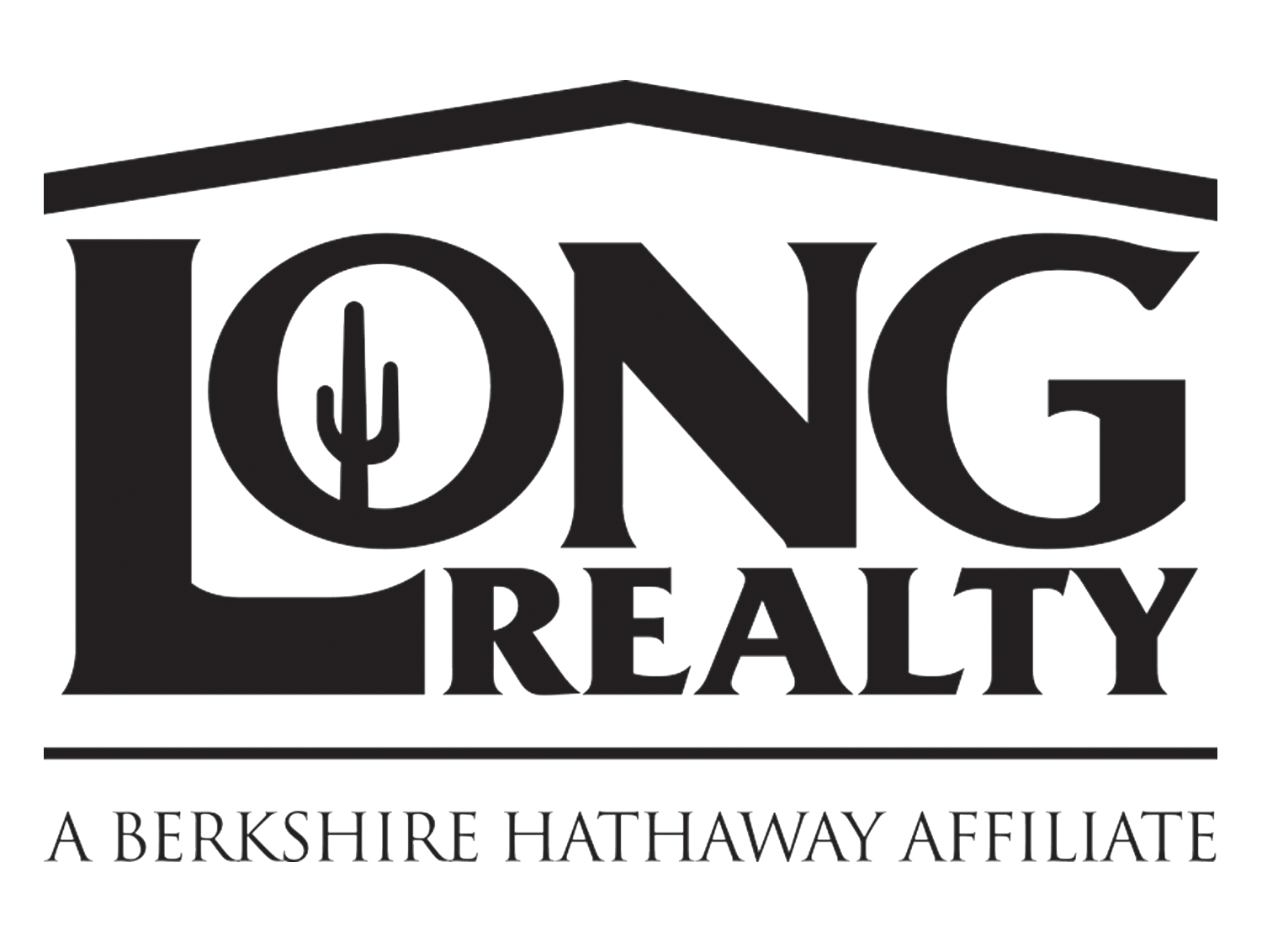

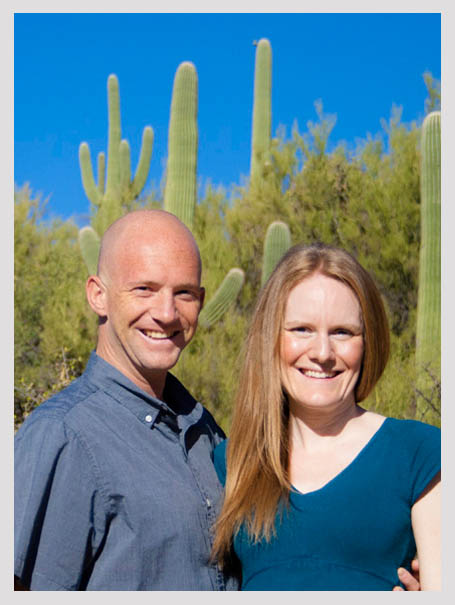









































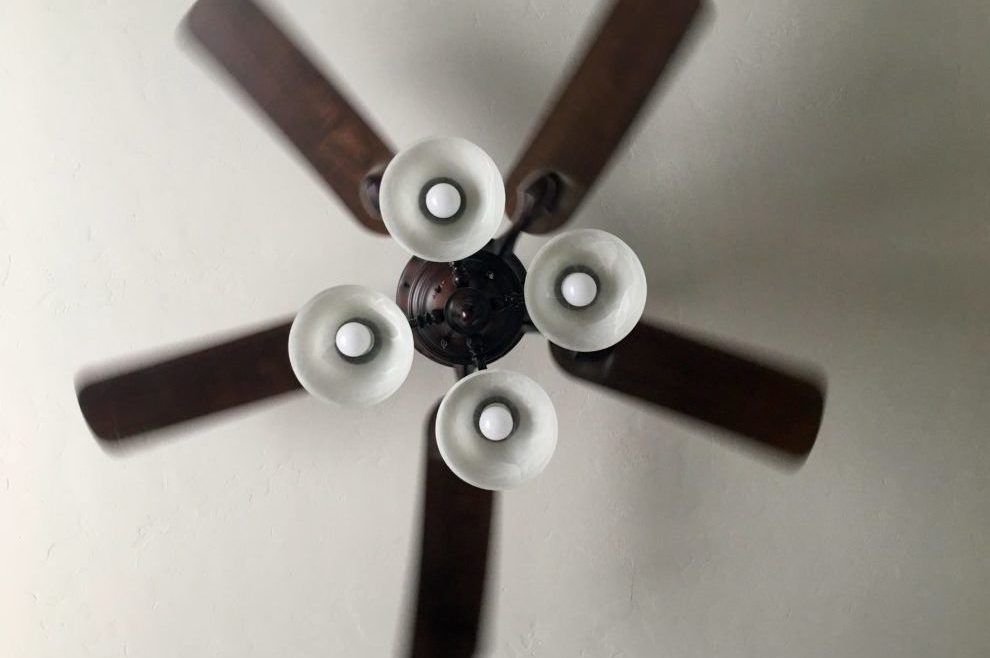


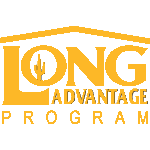
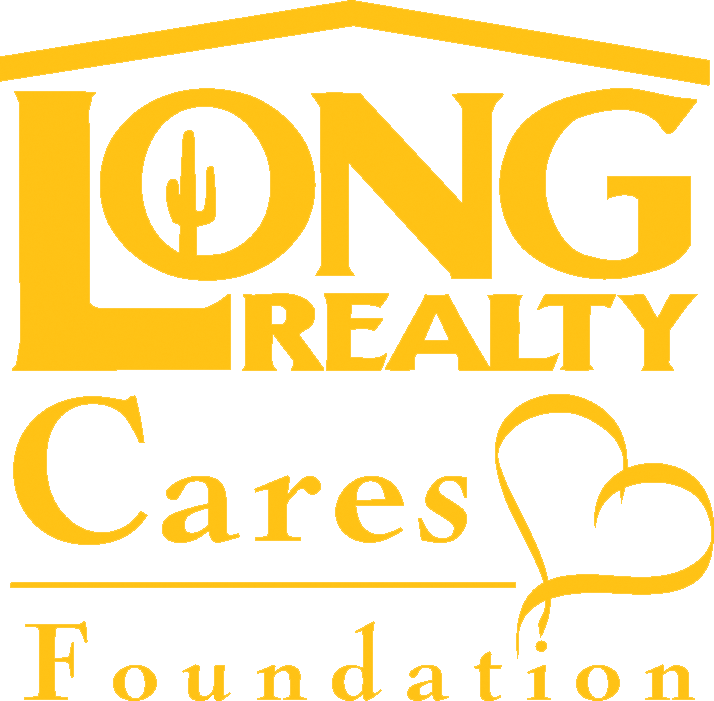
Connect With Us!